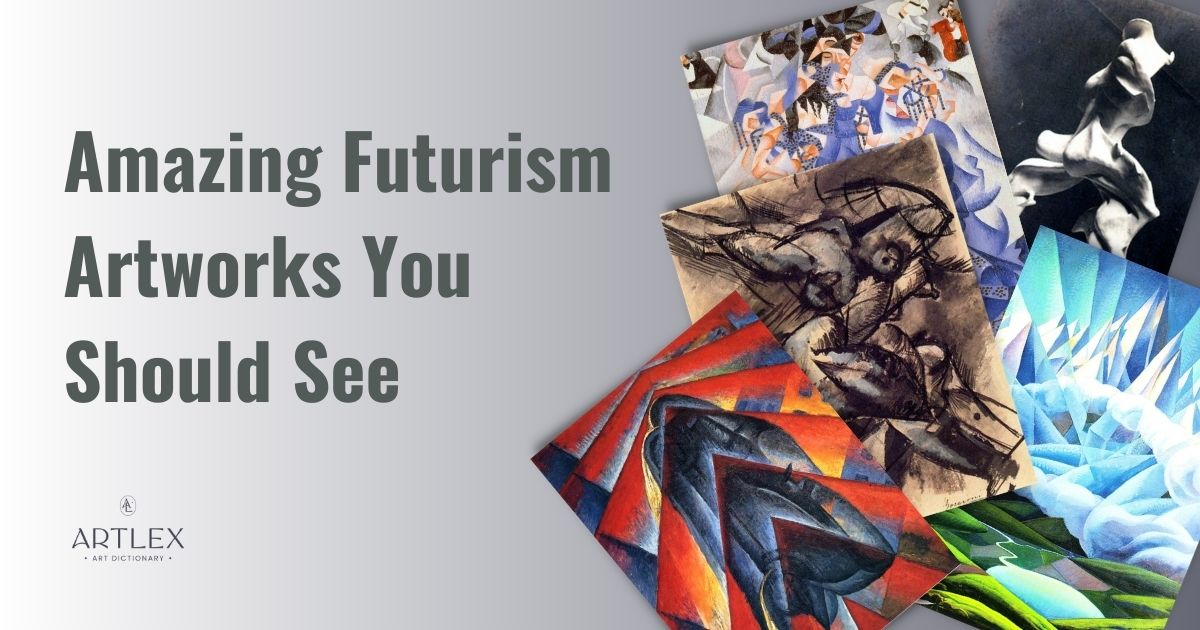
Futurism is an Avant-garde art and social movement that originated in Italy. The key document for the development of Futurism is the Manifesto of Futurism, which was published by Filippo Tommaso Marinetti in 1909. Several manifestos were created in the wake of futurist philosophy and all of them had a common attitude towards the past. This was based on an uncompromising rejection of the tradition while glorifying the cult of youth, industrialization, speed, technology, and modernization, often emphasizing the violent component of the struggle for cultural and wider social change. Futurism developed in literature as well as in painting, sculpture, architecture, industrial design, music, film, dance, and fashion.
Futurism influenced Surrealism, Art Deco, Cubo-futurism, Constructivism, Rayonism, Vorticism and Precisionism.
The characteristics of Futurism include: the rejection of traditional value frameworks in the field of culture, ie striving for art freed from the weight of its past, highlighting youth as a key capital of social development, technology, modernization of urban spaces, the dynamism of industrial plants, objects such as cars or airplanes. Notable futurist artists are Umberto Boccioni, Giacomo Balla, Carlo Carrà, Gino Severini, Elena Guro, Giorgio Morandi, Joseph Stella, and Aleksandra Ekster.
51 amazing futurism artworks include:
1. Unique Forms of Continuity in Space (Umberto Boccioni)
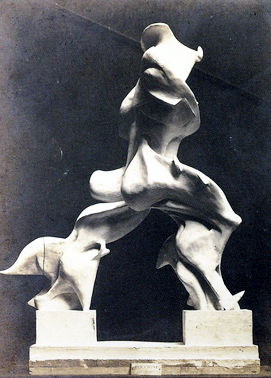
Umberto Boccioni made the Unique Forms of Continuity in Space in plaster in 1913. The original is kept at the Museu de Arte Contemporânea in Sao Paulo. The bronze castings of this sculpture have been made on several occasions since 1931. Dynamism as the dominant value of futurist artistic tendencies is manifested in this sculpture. The sculpture depicts a human-like figure in motion. With its composition, this sculpture corresponds to the Winged Victory of Samothrace in the context of the triumph of modernity over classical proportions. Unique Forms of Continuity in Space is based on the idea of synthetic continuity, which does not start from the premise of isolating a certain moment in the movement that is presented but refers to the synthesis of the overall experience of movement.
2. Dynamism of a Dog on a Leash (Giacomo Balla)
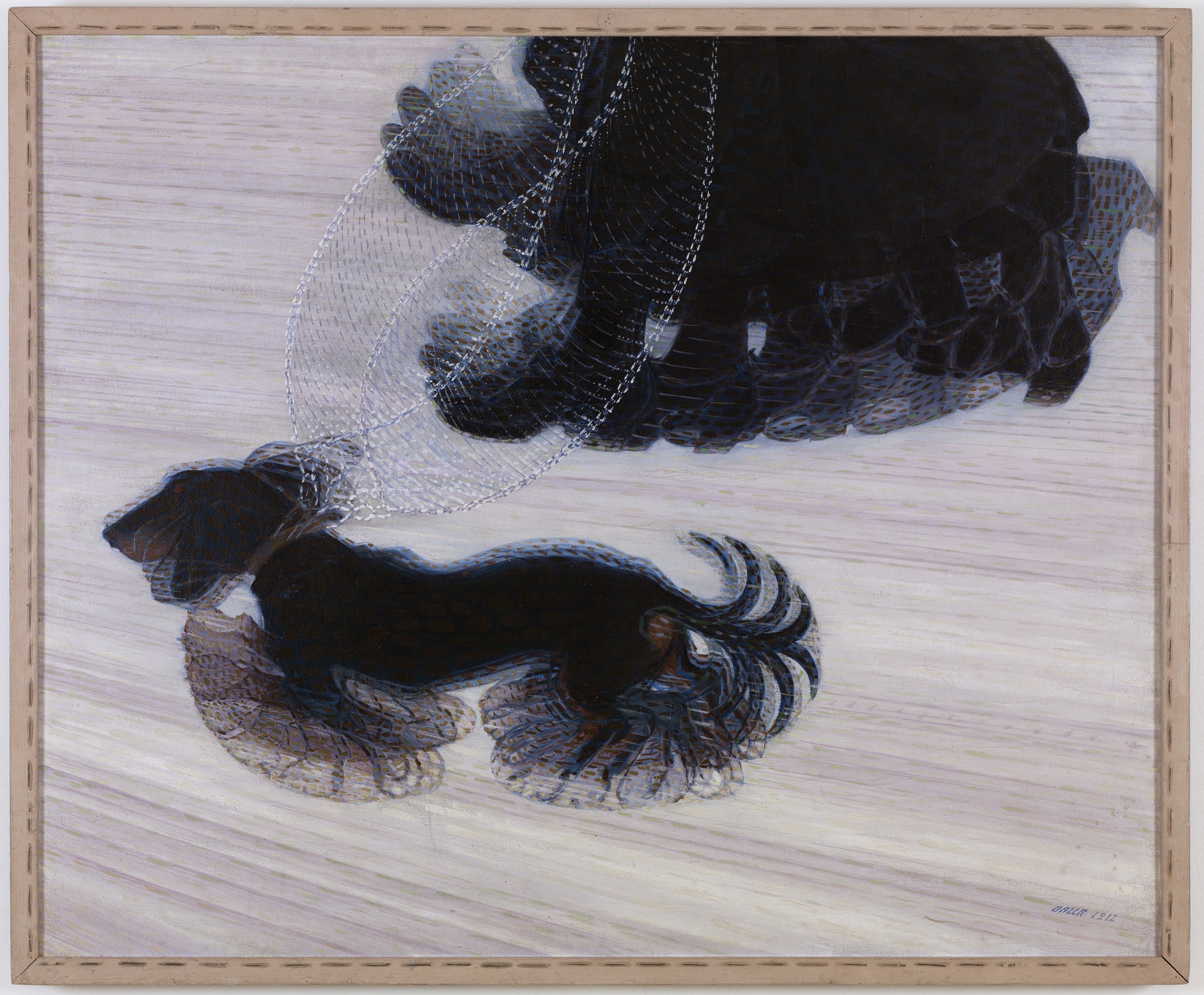
Giacomo Balla painted Dynamism of a Dog on a Leash in oil on canvas technique in 1912. This painting was exhibited at the Galerie Der Sturm’s Autumn Salon in Berlin in 1913 and is now at the Albright – Knox Art Gallery, in New York. The chronophotographic method was the starting point for the structure of this composition, which represents a dachshund walking on a leash held by a person whose feet are only visible in the painting. Remaining in the domain of futurist research of the dynamics of movement, Balla decided to do it by structuring the frame in such a way that the observer while watching this work anticipates a wider space in which this scene is only a detail.
3. Ascending Forms (or Ascending Forces) (Gerardo Dottori)
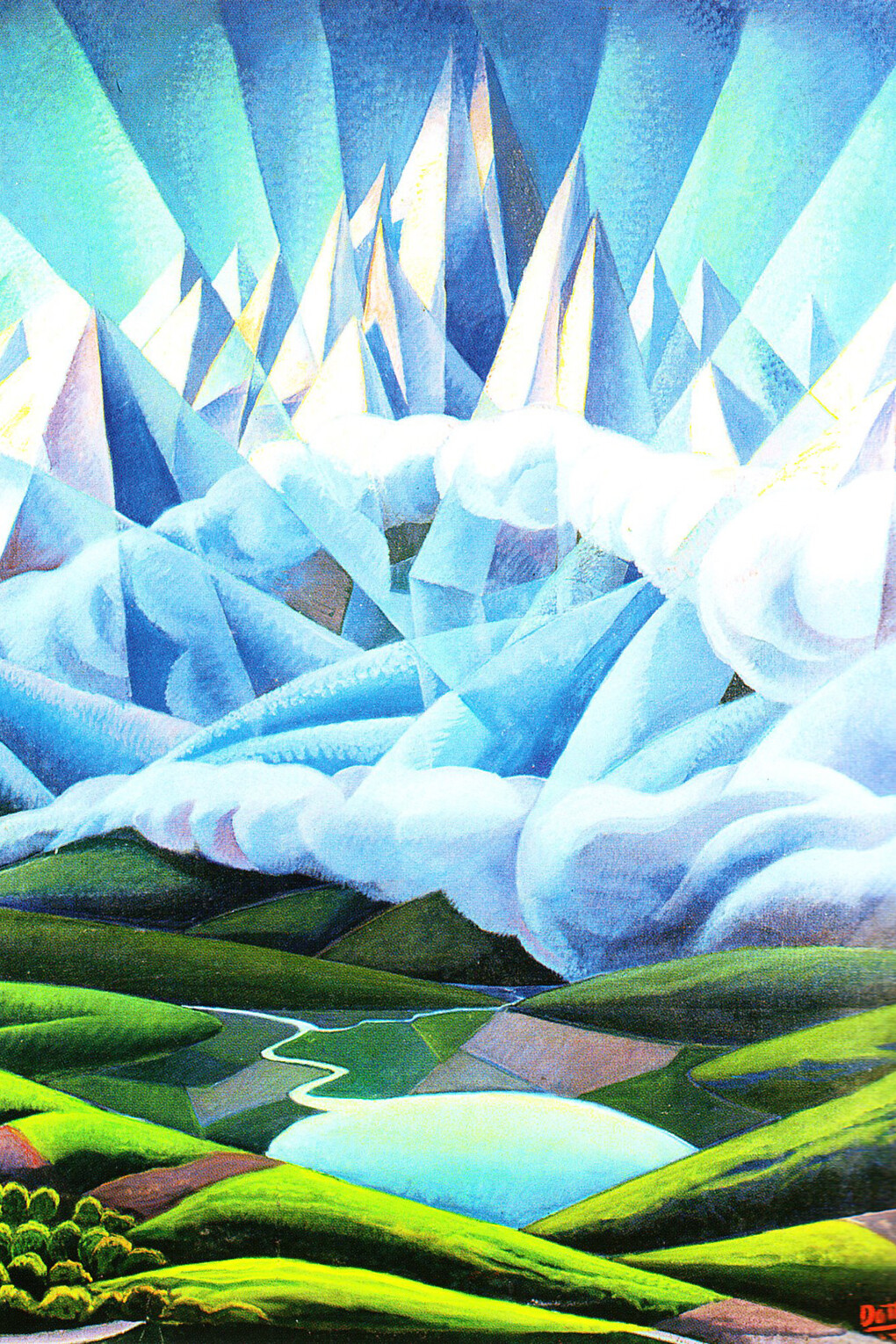
Gerardo Dottori painted Ascending Forms (or Ascending Forces) in the oil on canvas technique in 1930. The painting is on display at the Museo civico di Palazzo della Penna in Perugia. This painting is one in a series of landscapes of the Umbrian landscape. Dottori translated the futurist ideas of dynamism, which are usually applied to urban or industrial spaces, into the field of landscape painting, which proved to be more than suitable for this type of futurist experiment, especially in the form of aeropainting.
4. Ballerina in Blue (Gino Severini)
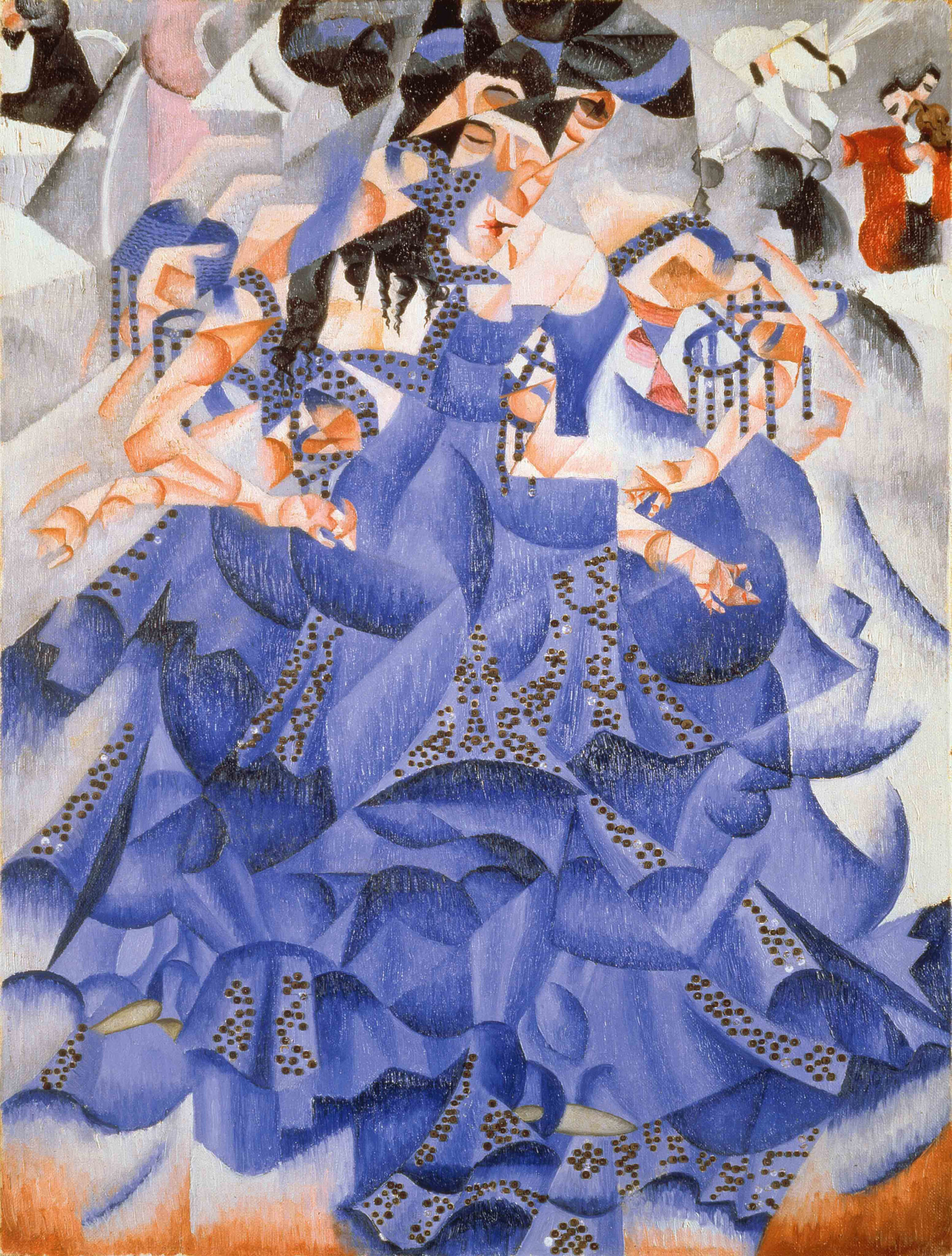
Gino Severini painted Ballerina in Blue in oil on canvas in 1912. This painting is now part of the collection of the Solomon R. Guggenheim Museum in New York. It is part of the futuristic tendency to represent the integrity of the continuous movement. Ballerina in Blue is a famous representative of the combination of a futurist approach to the phenomenon of movement and cubist geometrization.
5. Primavera Umbria (Gerardo Dottori)
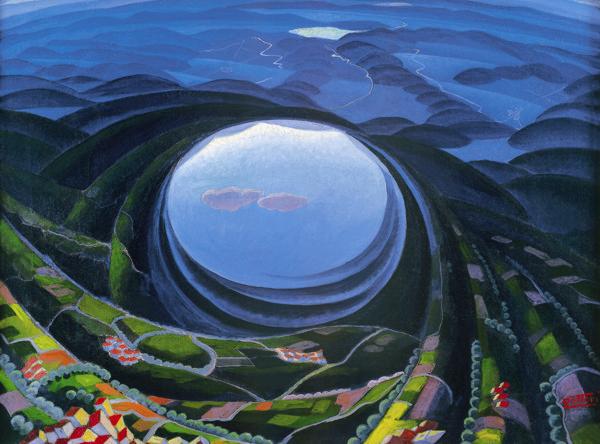
Gerardo Dottori painted Primavera Umbria in oil on canvas in 1923. This painting is part of the Museo Civico di Palazzo della Penna collection in Perugia. This painting is part of a series of Dottori’s futurist landscapes that were created mostly in Umbria. Dottori was one of the signatories of the Futurist Manifesto of Aeropainting in 1929. The phenomenon of aeropainting, to which Primavera Umbria also belongs, united the futurist fascination with technology and modern traffic, especially airplanes, and new landscape painting. Observing the landscape from an airplane, by introducing a moving view of space from a bird’s eye view, transformed the perception of the landscape in modern art.
6. Dynamism of a Car (Luigi Russolo)
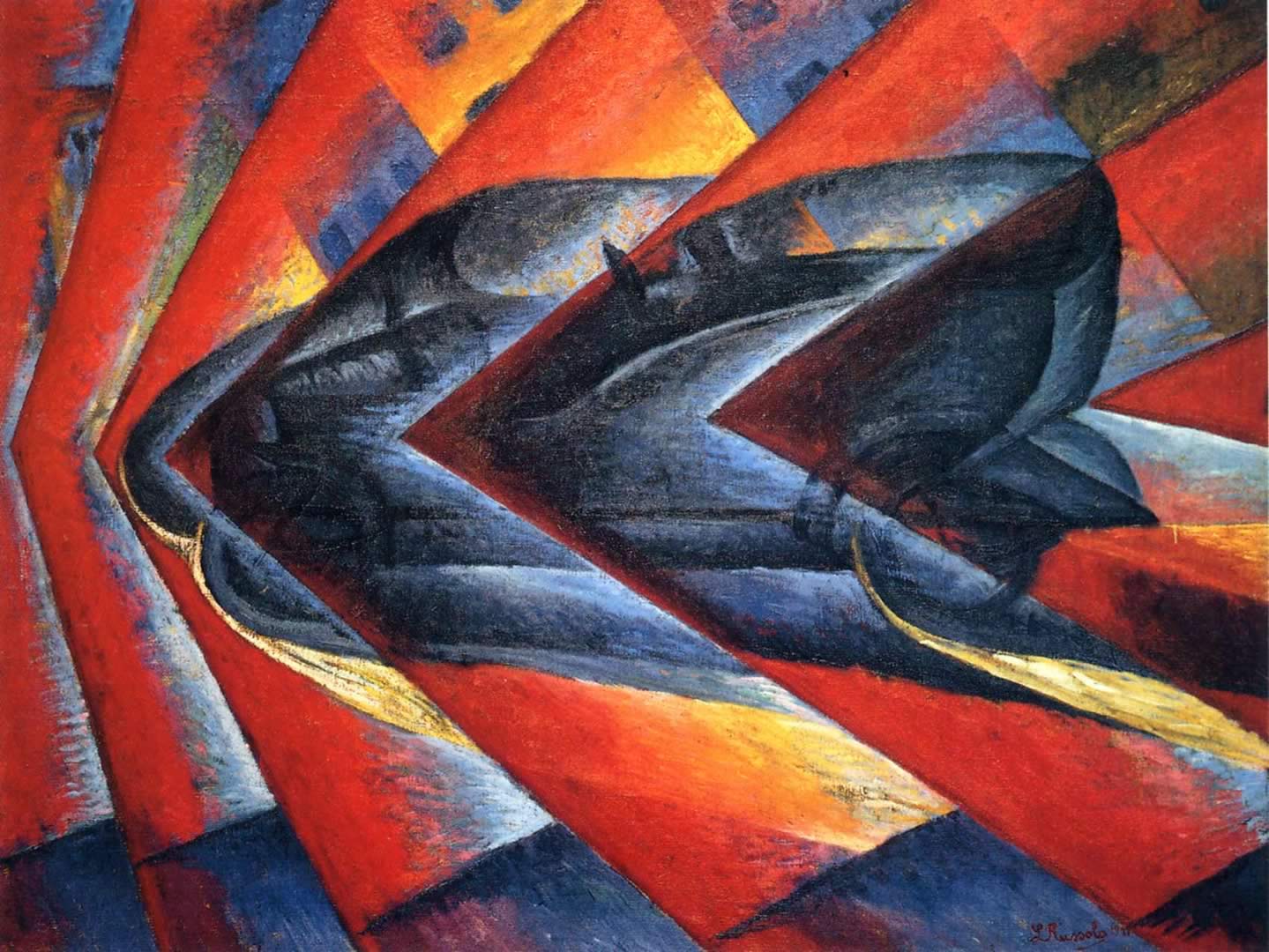
Luigi Russolo painted Dynamism of a Car in the oil on canvas technique in 1913. This painting is part of the Musée National d’Art Moderne collection in Paris. The dynamism of a Car is a painting that combines several thematic and formal solutions characteristic of Futurism. The topic chosen by Russolo testifies to the Futurist’s fascination with traffic and the development of the automobile industry. Another important element is the strategy of artistically shaping the speed at which this car is moving. Formally, this image is composed on the cubist principles of geometrization, which in this case, especially with the use of red elements, evoke the speed and direction of movement of this aerodynamic car.
7. Dynamic Decomposition (Umberto Boccioni)
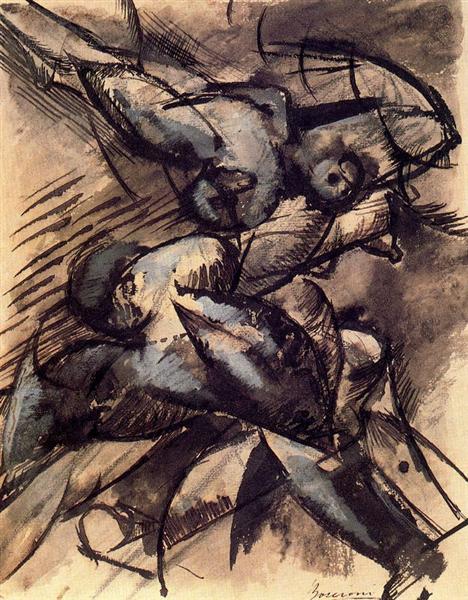
Umberto Boccioni made the Dynamic Decomposition in the technique of ink on paper in 1913. This work is part of the collection located in Sforza Castle in Milan. Dynamic Decomposition is one of Boccioni’s many works dealing with the topic of plastic dynamism. The idea represented by plastic dynamism refers to the authentic transmission of the simultaneity of the movement of an object. This simultaneity refers to the relationship between the absolute motion of an object, ie its movement in itself, and relative motion, which is the transformation that an object undergoes in relation to its moving or immovable environment.
8. Horizontal Volumes (Umberto Boccioni)
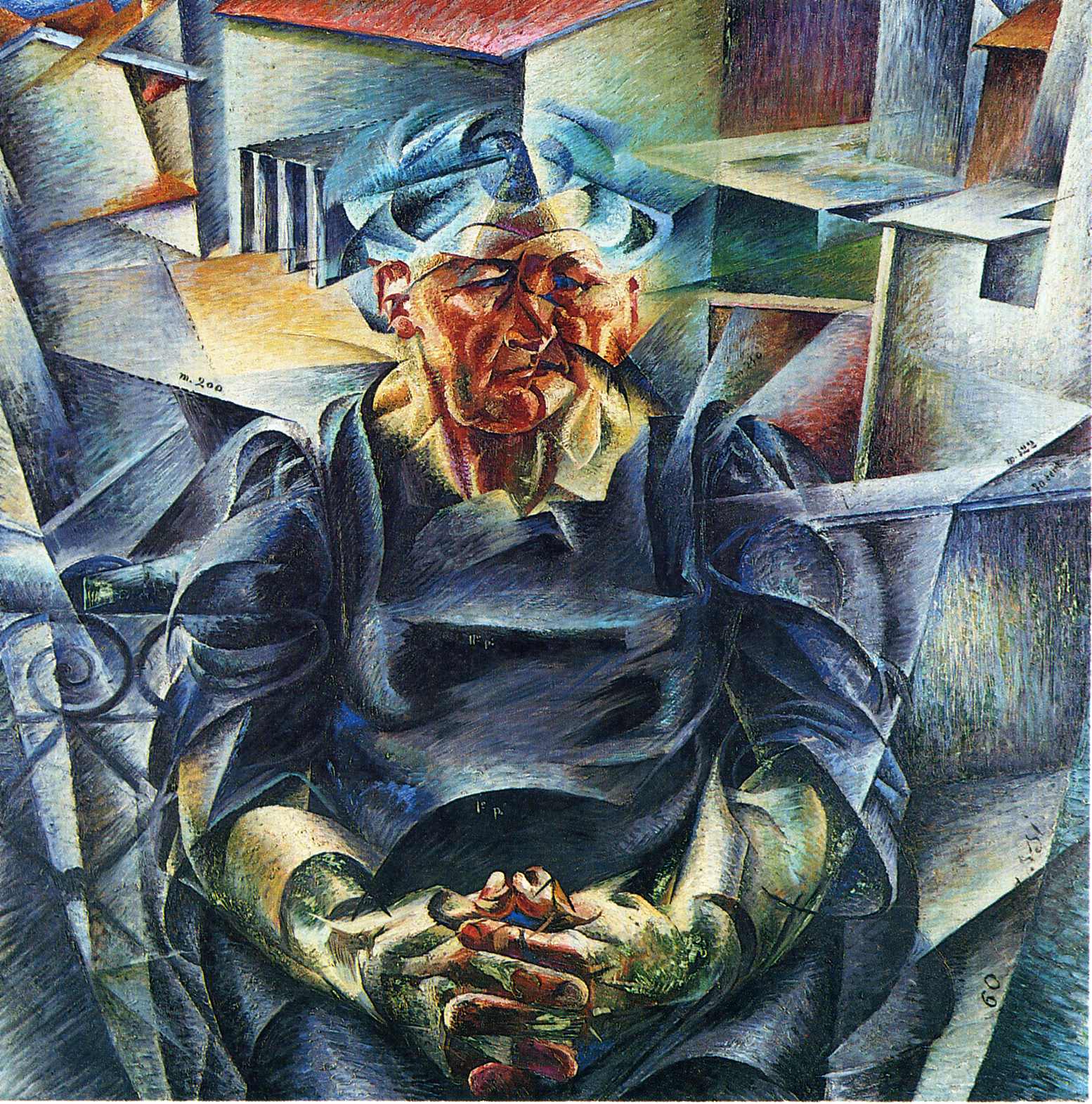
Umberto Boccioni painted Horizontal Volumes in oil on canvas in 1912. This painting is in the State Gallery of Modern Art in Munich. Horizontal Volumes in the formal aspect emphasize the divisionist approach that allowed the futurists the effect of flickering scenes. This painting problematizes the clearly defined boundaries between the interior and the exterior, as well as the position of the portrayed figure characteristic of traditional portrait painting.
9. Memories of a Night (Luigi Russolo)
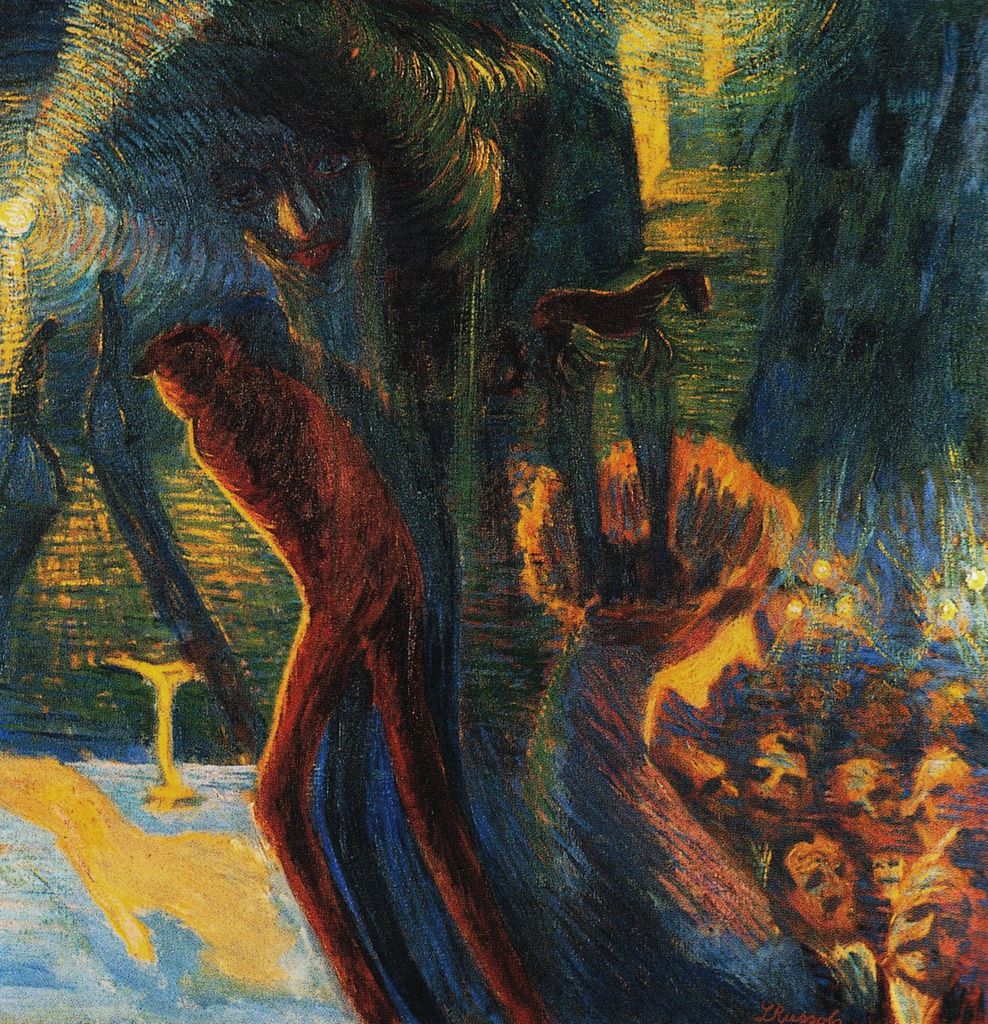
Luigi Russolo painted Memories of the Night in the oil on canvas technique in 1911. This painting is in a private collection. Memories of the night point to the post-impressionist tradition that Futurism has continued. The scientific principle of Divisionism, which was specially developed by the Pointillists for the Futurists, marked a space for researching dynamism in the domain of color. This painting is characterized by a composition based on a harmonious relation of complementary colors, playing with perspective and light as well as erasing clear boundaries between interior and exterior.
10. Futuristic woman (David Burliuk)

David Burliuk, painted the Three-Eyed Futuristic Woman, in oil technique on plywood in 1910. This painting is part of the collection of the Moscow Museum of Modern Art in Moscow. Burliuk is one of the earliest followers of Italian futurism in Russia and was one of the authors of the famous manifesto A Slap in the Face of Public Taste. The Three-Eyed Futuristic Woman in a Cubo-futurist manner brings a new interpretation of the traditional portrait form by introducing a characteristic kind of dynamism through the multiplication of body parts in this case the eyes.
11. Series of 8 Rhinoceroses (Fortunato Depero)

Fortunato Depero made the Series of 8 Rhinoceroses from wood in 1920. This series is on display at the Museum of Modern and Contemporary Art of Trento and Rovereto. Fortunato Depero is one of the most prominent representatives of Futurism in the field of applied art. This Series of 8 Rhinoceroses is a successful example of the synergy of children’s toy likeability and futurist design.
12. What the tram told me (Carlo Carrà)
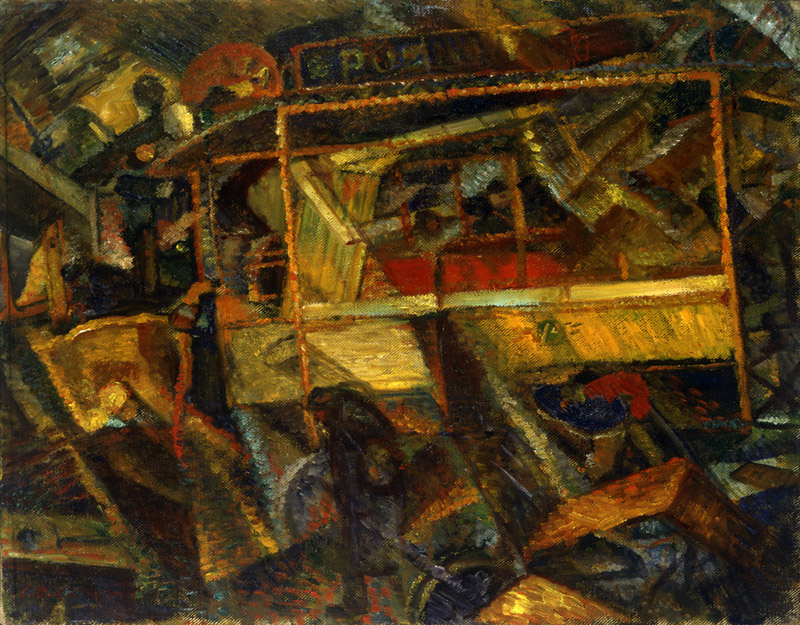
Carlo Carrà painted What the tram told me in the oil on canvas technique in 1911. This painting is part of the collection of the Museum of Modern and Contemporary Art of Trento and Rovereto. What the tram told me is representative of futurist tendencies toward examining the visual capacities of the traffic experience. In addition to the traffic-related topic, this painting is formally based on the divisionist principles of matching the fields of complementary colors.
13. Science against Obscurantism (Giacomo Balla)
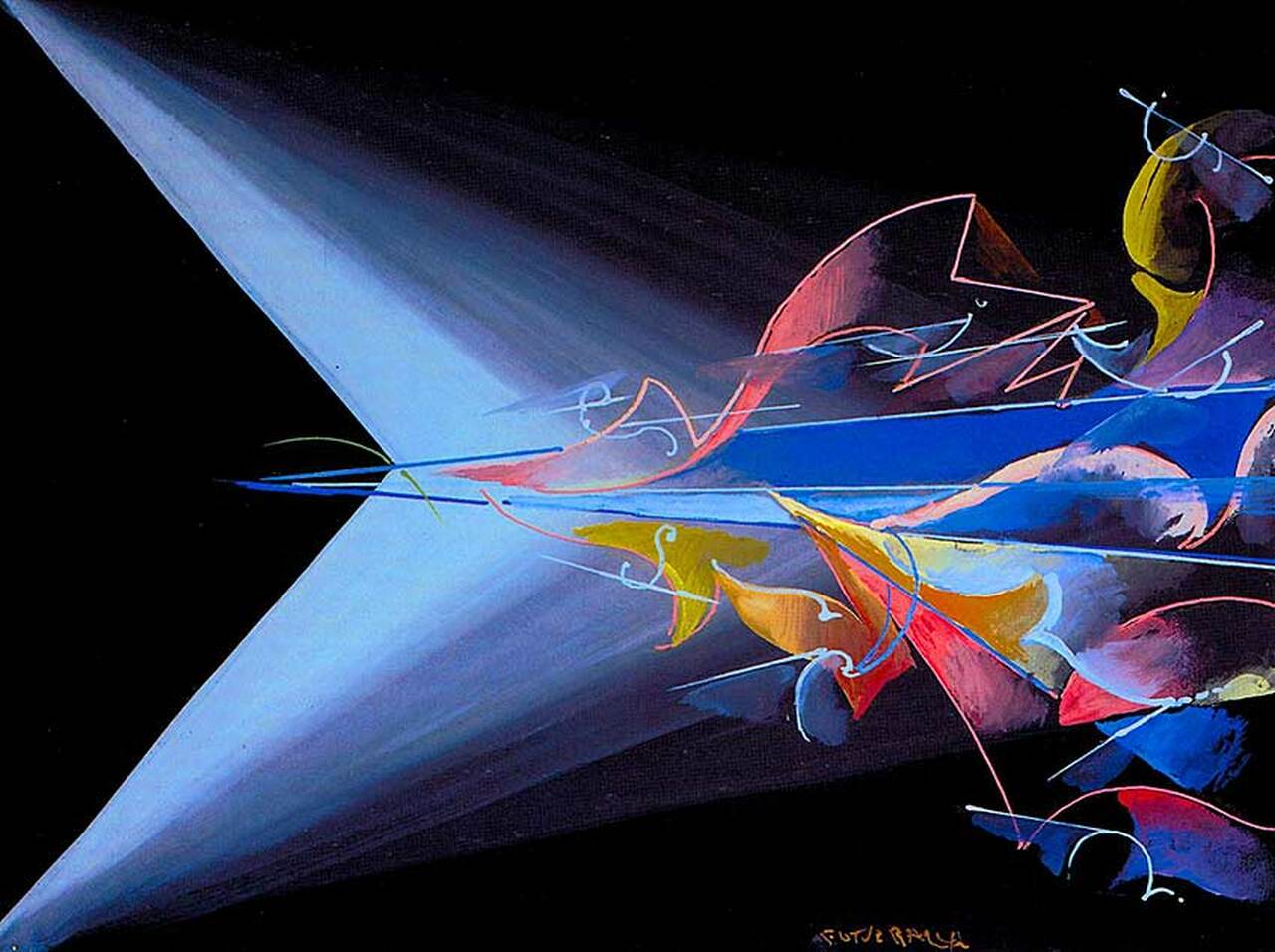
Giacomo Balla painted Science against Obscurantism in the oil on canvas technique in 1920. This painting is in the National Gallery of Modern and Contemporary Art in Rome. The Futurists built an extremely strong utopian faith in the triumph of science for the sake of creating a new society. It is this painting in abstract forms that bring the symbolism of that philosophy. Balla was contrasting the dynamism and penetrating characteristics of colored fields with the staticity and passivity of black fields. Black, in this case, symbolizes the sluggishness and archaicness of European societies as opposed to the progressiveness of science symbolized by other colors which Balla used to present a revolutionary theme.
14. Speed of an automobile (Speed n. 1 ‘) (Giacomo Balla)
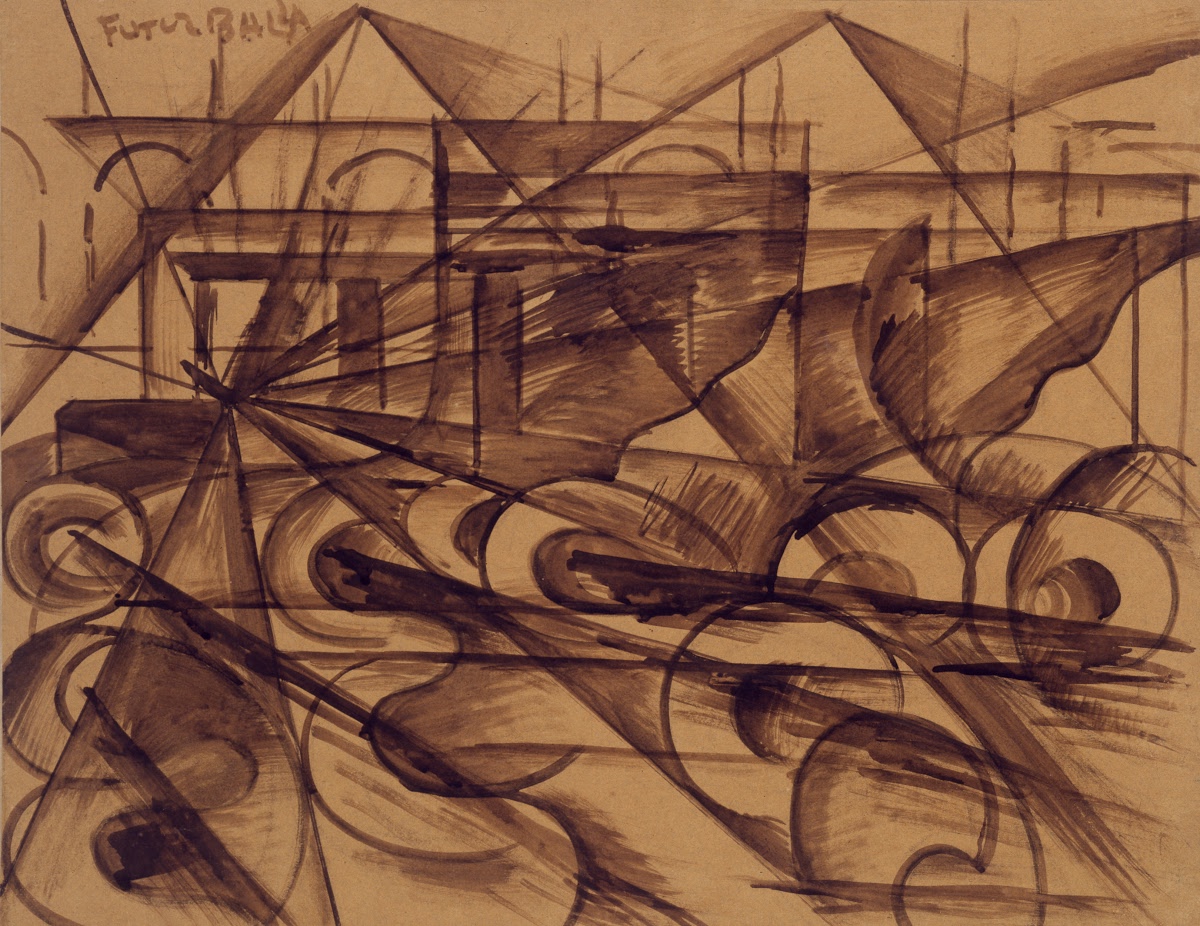
Giacomo Balla made Speed of an automobile (Speed n. 1 ‘) in the technique of Indian ink wash on lined paper, in 1913. This drawing is kept in the Museum of Modern and Contemporary Art of Trento and Rovereto. This work is part of a series of studies known as Speed of an automobile. Balla explored, in various techniques, the principles of the visual characteristics of dynamism as well as the relations of a moving car with the architecture that surrounds it.
15. Solidity of Fog (Luigi Russolo)
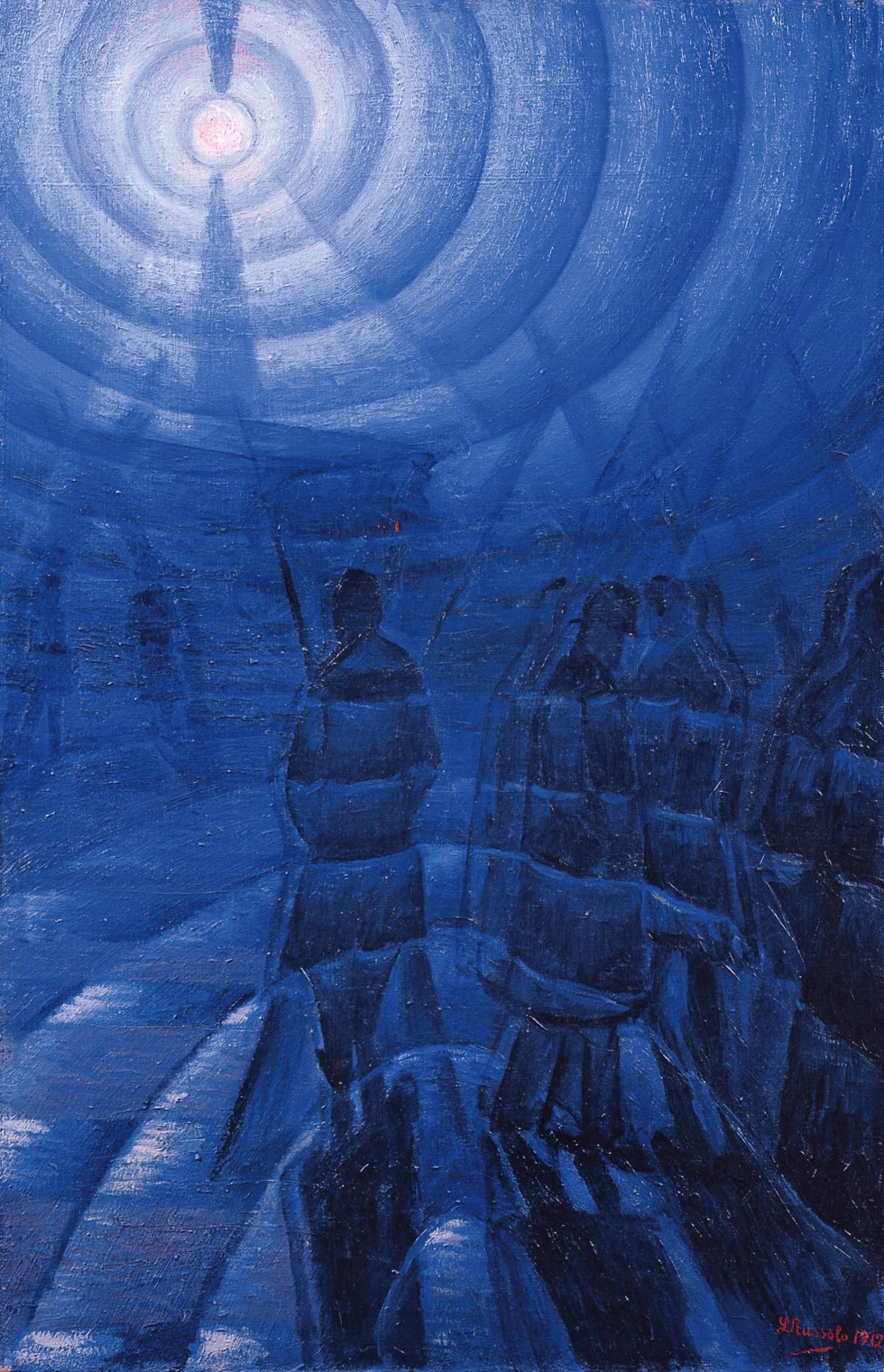
Luigi Russolo painted Solidity of Fog in the oil on canvas technique, in 1912. This painting is part of the Peggy Guggenheim Collection in Venice. Russolo continued the Neo-Impressionist tradition by experimenting with the light qualities of color. Opting for simplified forms or contours of figures, Russolo created space for different shades of blue as the dominant color of the painting, which had an almost monochrome character as the end effect.
16.Wind dynamics (Emilio Pettoruti)

Emilio Pettoruti did Wind dynamics in the technique of drawing on paper, in 1915. This work is part of the permanent exhibition of the National Museum of Fine Arts in Buenos Aires. Pettoruti has been dealing with the phenomenon of dynamism for a long time, in addition to the Wind dynamics, the works Dynamic Expansion and Spatial Dynamics are also known. In making these studies, Pettoruti refused to use color and separated his starting point for the study of dynamism from the starting point of most Futurists. The aim of his work was to isolate the characteristics of dynamism in itself, that is, to transfer its energy by visual means without including the relation of the dynamism with the space that surrounds it. Pettoruti was a pioneer of Cubo-futurist tendencies in Argentine art.
17. Cannons in action (Gino Severini)

Gino Severini painted Cannons in action in oil on canvas, in 1915. This painting is part of the collection of the Museum of Modern and Contemporary Art of Trento and Rovereto. Severini was one of the most ardent supporters of the futurist motto – War is a motor for art. This painting was created in the second year of then, the most massive conflict in the history of civilization. The First World War as the first mechanized war was the reason for the emergence of this painting as a praise of the war. Using simplified geometrized forms, Severini accelerated the glorification of cannons by using text that achieves the effect of narrating the moment the cannons burst.
18. Urban Landscape with Chimneys (Mario Sironi)
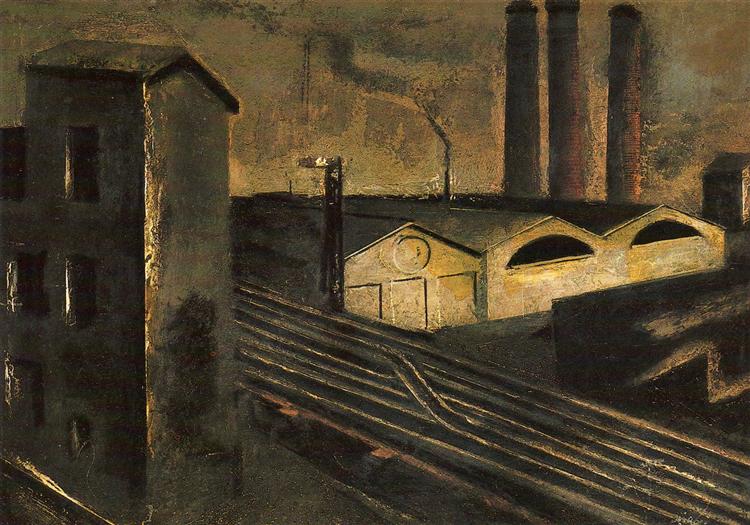
Mario Sironi painted the Urban landscape with the chimneys in the oil on canvas technique, in 1930. This painting is in the Pinacoteca di Brera in Milan. This artwork emerges on the wave of fascination that the Futurists felt towards modernization in terms of urbanism, technological revolution as well as the accelerated development of the industry. Using reduced colorism, Sironi created an authentic composition based on the relation between vertical and horizontal fields.
19. Dynamism of a Cyclist (Umberto Boccioni)
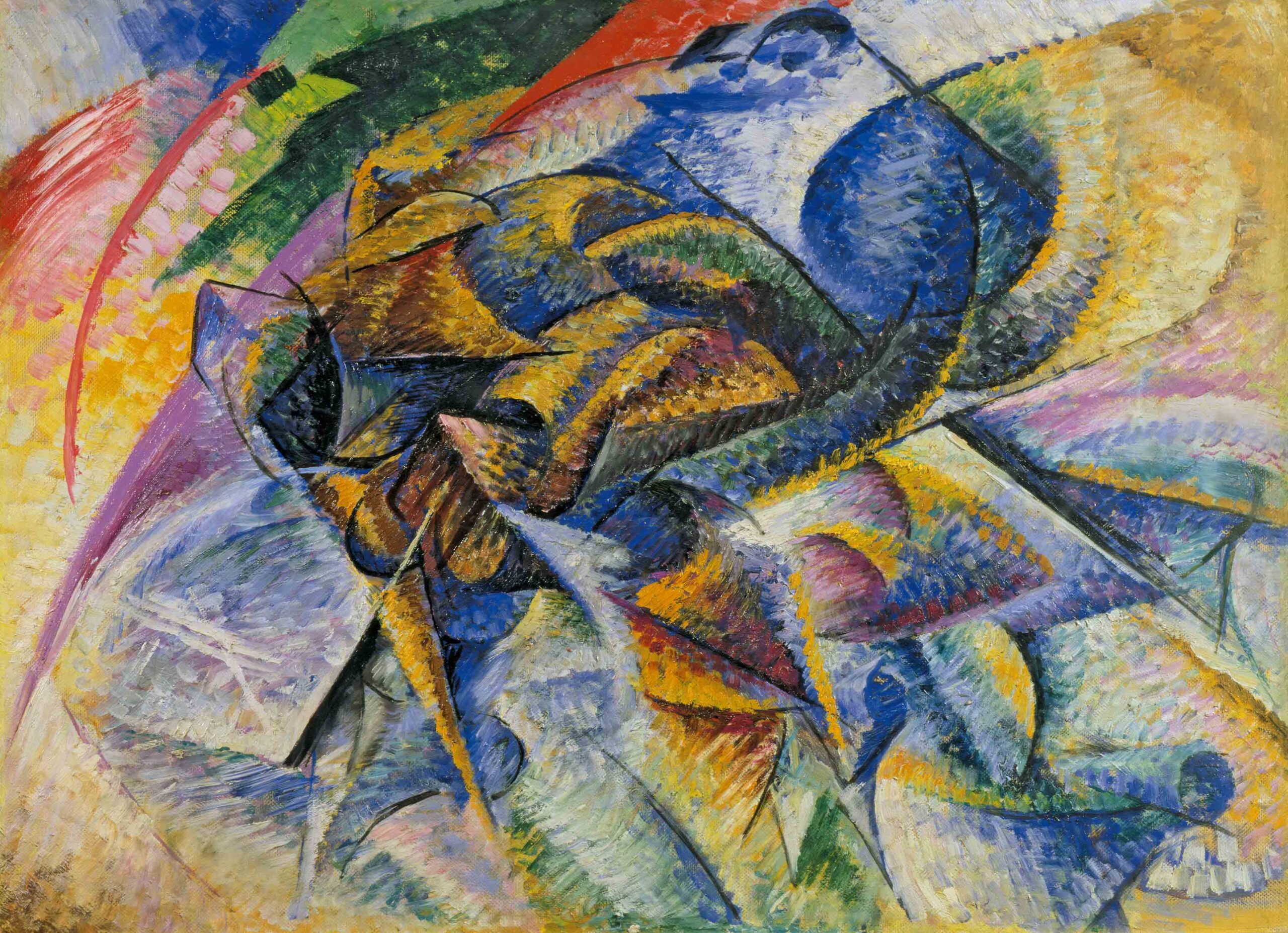
Umberto Boccioni painted Dynamism of a Cyclist in the oil on canvas technique, in 1913. This painting is part of the Peggy Guggenheim Collection in Venice. Although it does not represent a technical achievement of their time, the bicycle inspired many Futurists. During the work on this painting, Boccioni made numerous drawings and studies. The drawing, in the case of this artwork, is based on the relation between the force lines and echoing curves. A drawing for the Dynamism of a Cyclist, built on the interrelations of these lines should show how a figure or object would resolve itself if it followed the tendencies of its own forces during movement. In addition to futurist geometrization and cubist segmentation of planes, this painting is also characterized by its distinct divisionist character.
20. Triptych of speed – the way (Gerardo Dottori)
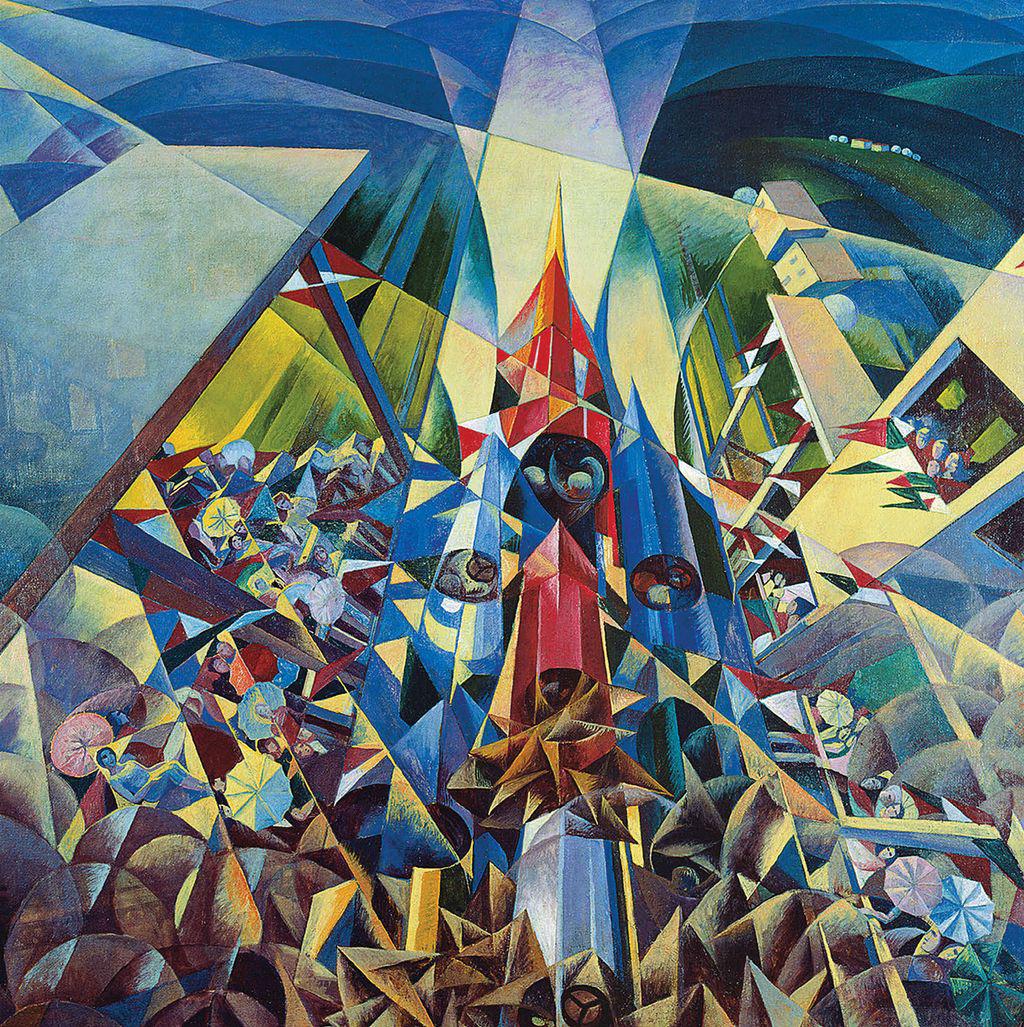
Gerardo Dottori painted Triptych of speed – the way in oil on canvas technique, in 1926. This painting is part of the collection of the Civic Museum of Palazzo della Penna in Perugia. In addition to the painting The Way, The Triptych of Speed also includes The Journey and The Arrival. Dottori is one of the most important representatives of Aeropainting. A new approach to landscape painting is based on observing space in motion from a bird’s eye view. The principles of dynamism are realized here through the changeability of the scene to the one who observes it, as well as the changes that the observed space itself is going through. This painting is characterized by prominent geometrization as well as composing pairs of complementary colors, characteristic of the divisionist approach.
21. The Voice of the City of New York Interpreted (Joseph Stella)

Joseph Stella painted The Voice of the City of New York Interpreted in oil and tempera on canvas between 1920 and 1922. This polyptych is part of the collection of The Newark Museum of Art. The Voice of the City of New York Interpreted consists of five monumental panels. The panels that frame the polyptych are The Port as an access point to the city and The Bridge as a triumph of technology and modernity that transforms the city. Water as a common dominant motif of these panels gives the work a symmetrical frame that will be further upgraded by the organization of the panels. The next two panels have the same name, The White Way. Both panels, with a sumptuous color palette as well as cross-linked geometrized forms, bring elements that represent Broadway. The central panel, which has the most monumental dimensions, is called Skyscrapers. This painting in Cubo-futurist forms represents the triumph of modernity in building the city’s identity through the glorification of both its industry and lavish architecture.
22. Dawn in Flight (Gerardo Dottori)
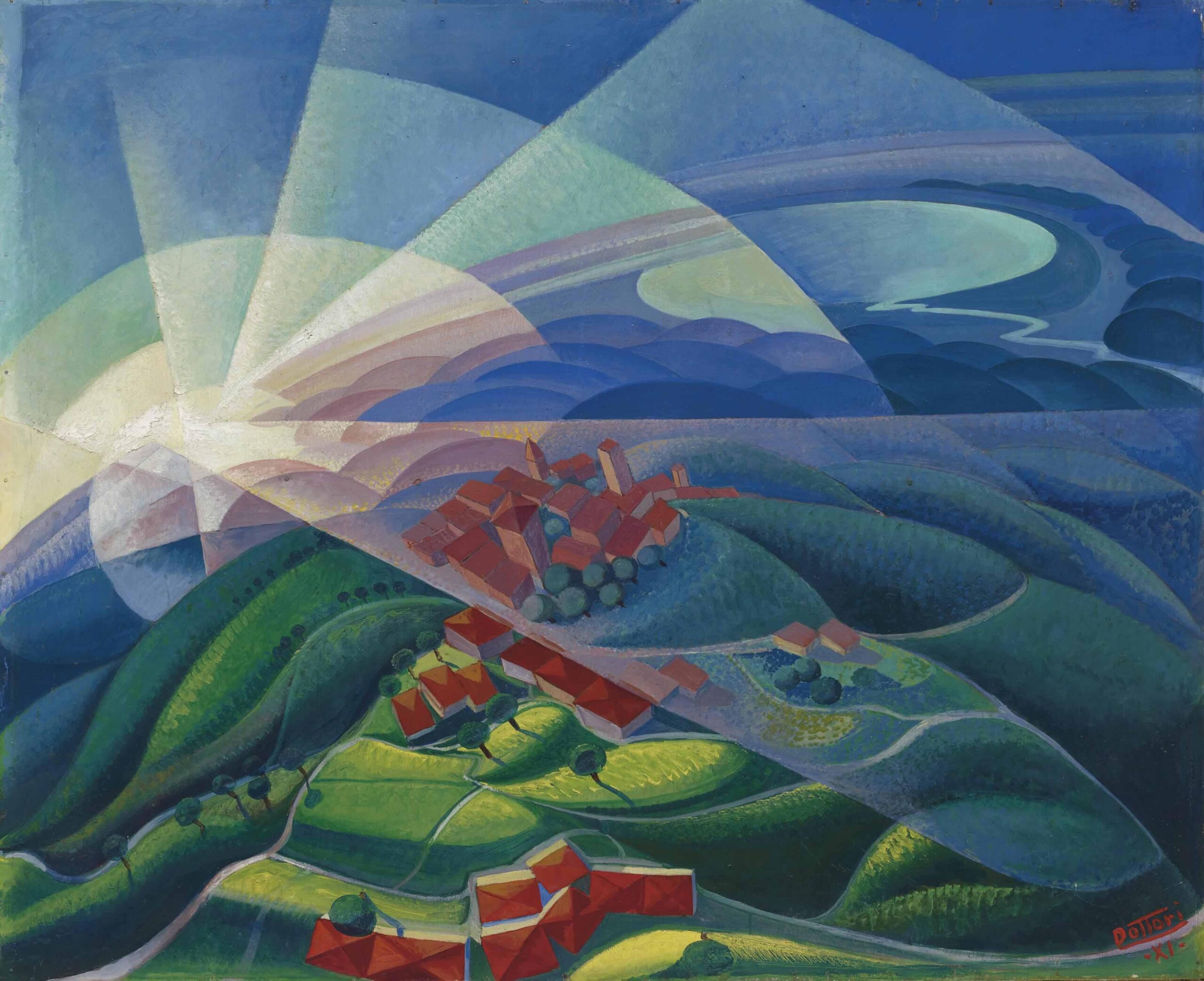
Gerardo Dottori painted Dawn in Flight in the tempera on panel technique, in 1933. This painting is in a private collection. Dawn in Flight is one of the most representative examples of Dottori’s Aeropainting. In addition to inventiveness in the process of treating perspective, this painting, with its geometrized composition, brings a divisionist notion of the refraction of light.
23. The Funeral of the Anarchist Galli (Carlo Carrà)
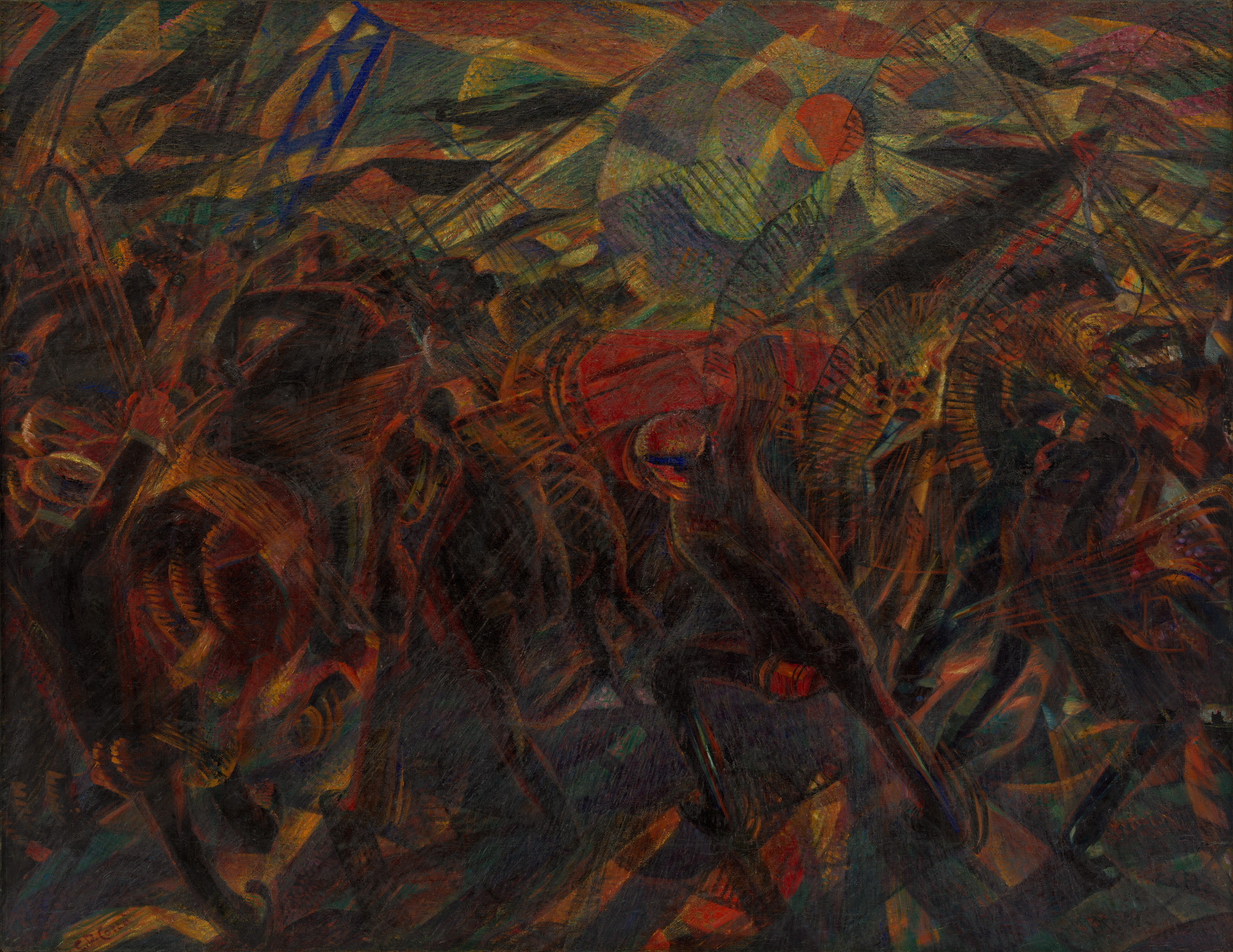
Carlo Carrà painted The Funeral of the Anarchist Galli in the oil on canvas technique, in 1911. This painting is part of the collection of the Museum of Modern Art in New York. Using divisionist principles and expressive drawing, Carrà achieved the impression of the trembling and unwavering nature of the scene, which he himself attended. It is about the funeral of Italian anarchist Angelo Galli, who was killed by the police during the 1906 strike. After the anarchists violated the ban on gatherings issued by the police, there was a conflict that Carrà conveys with this composition in the color vibrancy of light and shadow.
24. Abstract Speed + Sound (Giacomo Balla)
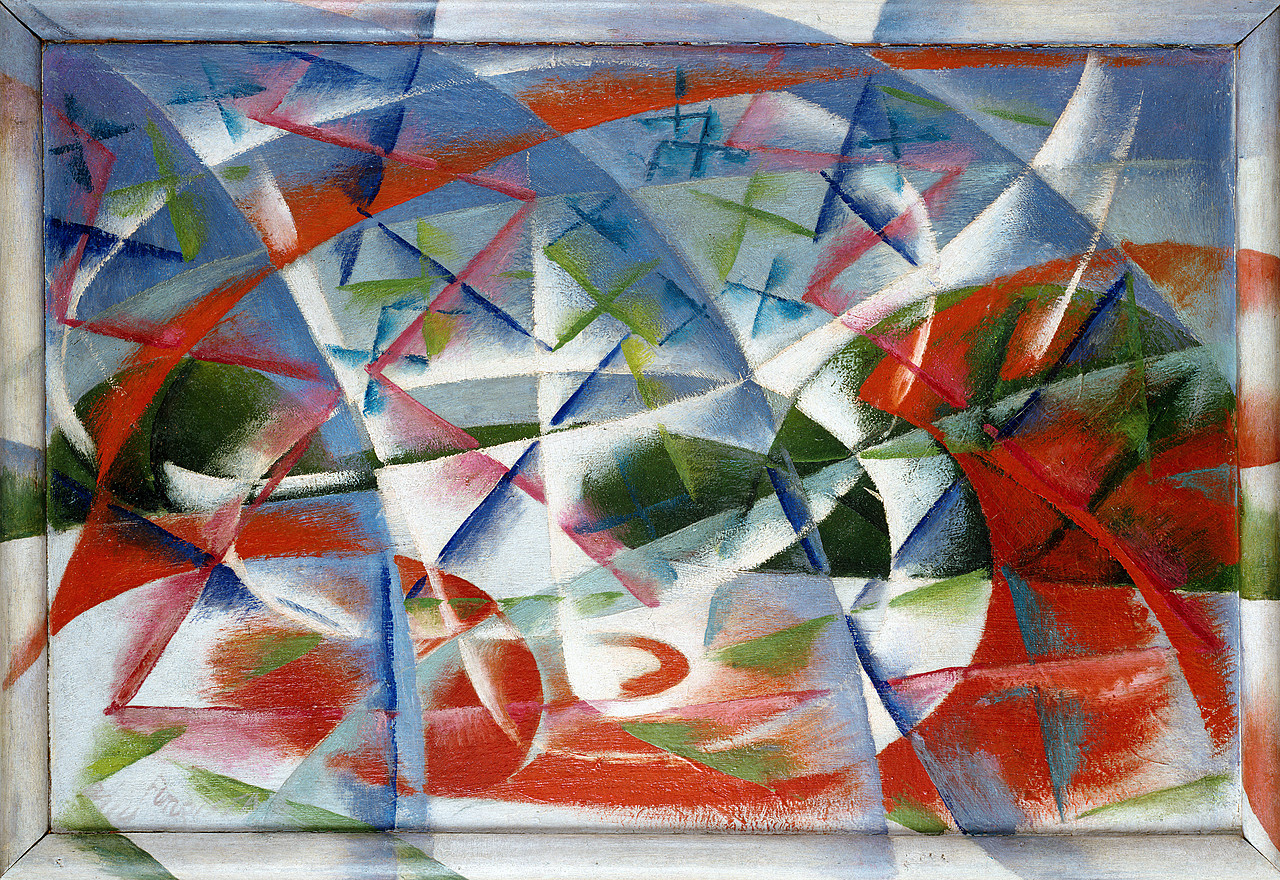
Giacomo Balla painted Abstract Speed + Sound in oil on canvas, from 1913–to 14. This painting is part of the Peggy Guggenheim Collection in Venice. During the work on this painting, Balla made numerous studies of the movement. The car has often been the focus of these researches, and the triptych of which this painting is a part, which follows the relationship between the car in motion and the landscape, stands out. The triptych consists of Line of Force + Landscape, Abstract Speed + Sound, and Abstract Speed - The Car has Passed. Abstract Speed + Sound is characterized by geometrization that has led the object to an almost completely abstract form, especially considering the crisscrossing lines that represent the sound of a moving car. The intensity of the scene itself is further enhanced by the relationship of complementary colors that is transferred from the canvas to the picture frame, thus entering the space of the observer.
25. Simultaneous Visions (Umberto Boccioni)
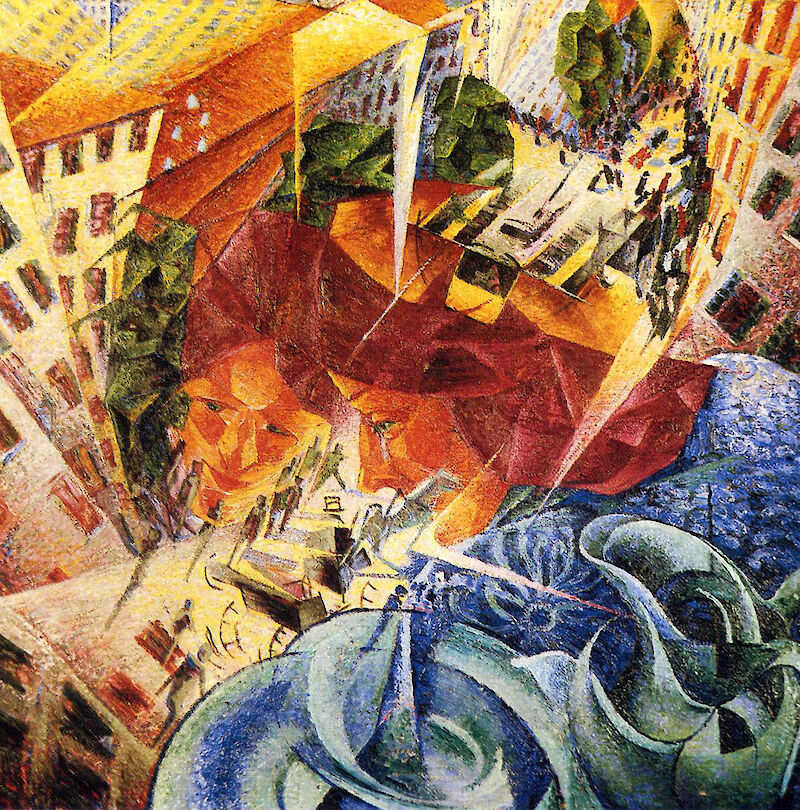
Umberto Boccioni painted Simultaneous Visions in the oil on canvas technique, in 1912. This painting is in the Von der Heydt Museum in Wuppertal. Simultaneous Visions is characterized by Boccioni’s synthesis of sensations from the outside world with the inner feelings of the subject. In the painting Simultaneous Visions, this connection is achieved by permeating the elements of the exterior with the human figure that observes that architecture, all with the aim of presenting the process of permanent transformation.
26. Mater (Umberto Boccioni)
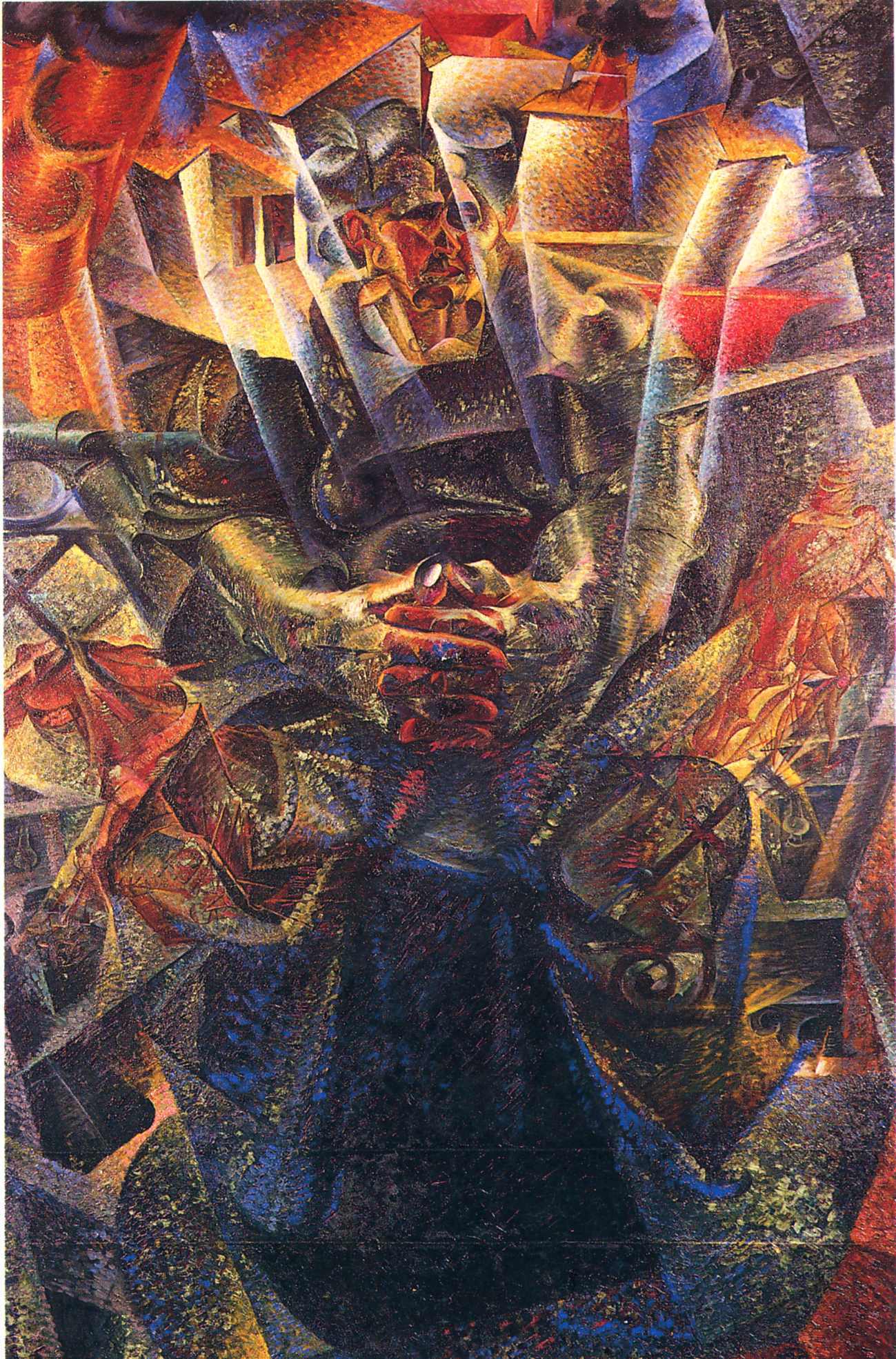
Umberto Boccioni painted Mater in the oil on canvas technique, in 1912-1913. This painting is part of the Peggy Guggenheim Collection in Venice. This painting is a portrait of Boccioni’s mother who is presented frontally sitting on the balcony of her house. Boccioni’s painting process contained geometrization, the use of complementary colors as well as dramatic lighting that radiates from both Milanese architecture and the figure of the artist’s mother. The starting point of the overall dynamics of the entire portrait is at the same time the only stable and strongly static element are the hands of the artist’s mother positioned in the center of the composition.
27. States of Mind I: The Farewells (Umberto Boccioni)
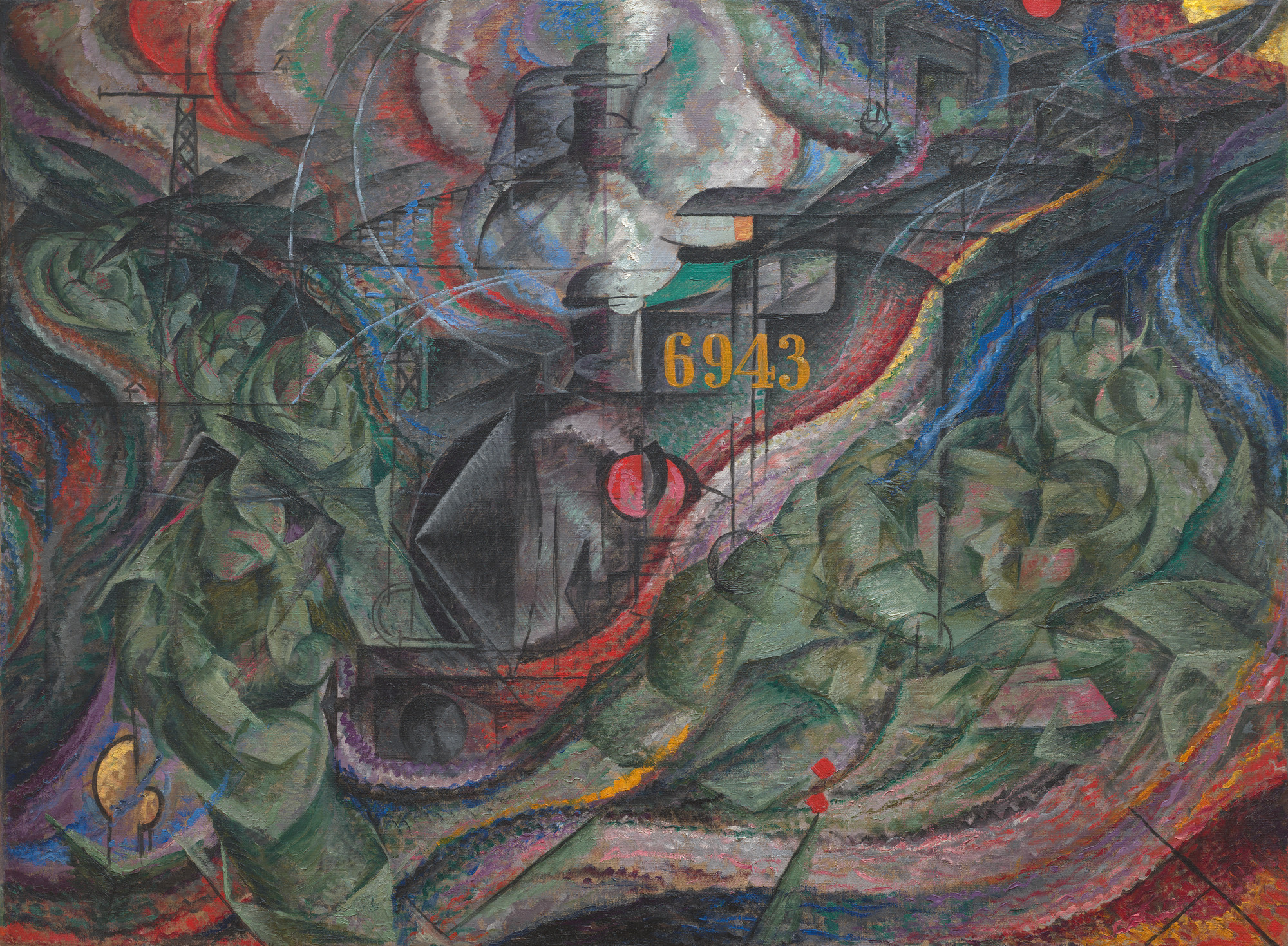
Umberto Boccioni painted States of Mind I: The Farewells, in the oil on canvas technique, in 1911. This painting is in the Museum of Modern Art in New York. States of Mind I: The Farewells is one of three in this series that includes both Those Who Go and Those Who Stay. This series deals with the phenomenon of increasing mobility of the population. The space of the railway station, the anguish of collective movement, as well as the parting, and the psychological weight that uncertainty carries, are the spatial and emotional frameworks that Boccioni dealt with in this series.
28. Attack of the Lancers (Umberto Boccioni)
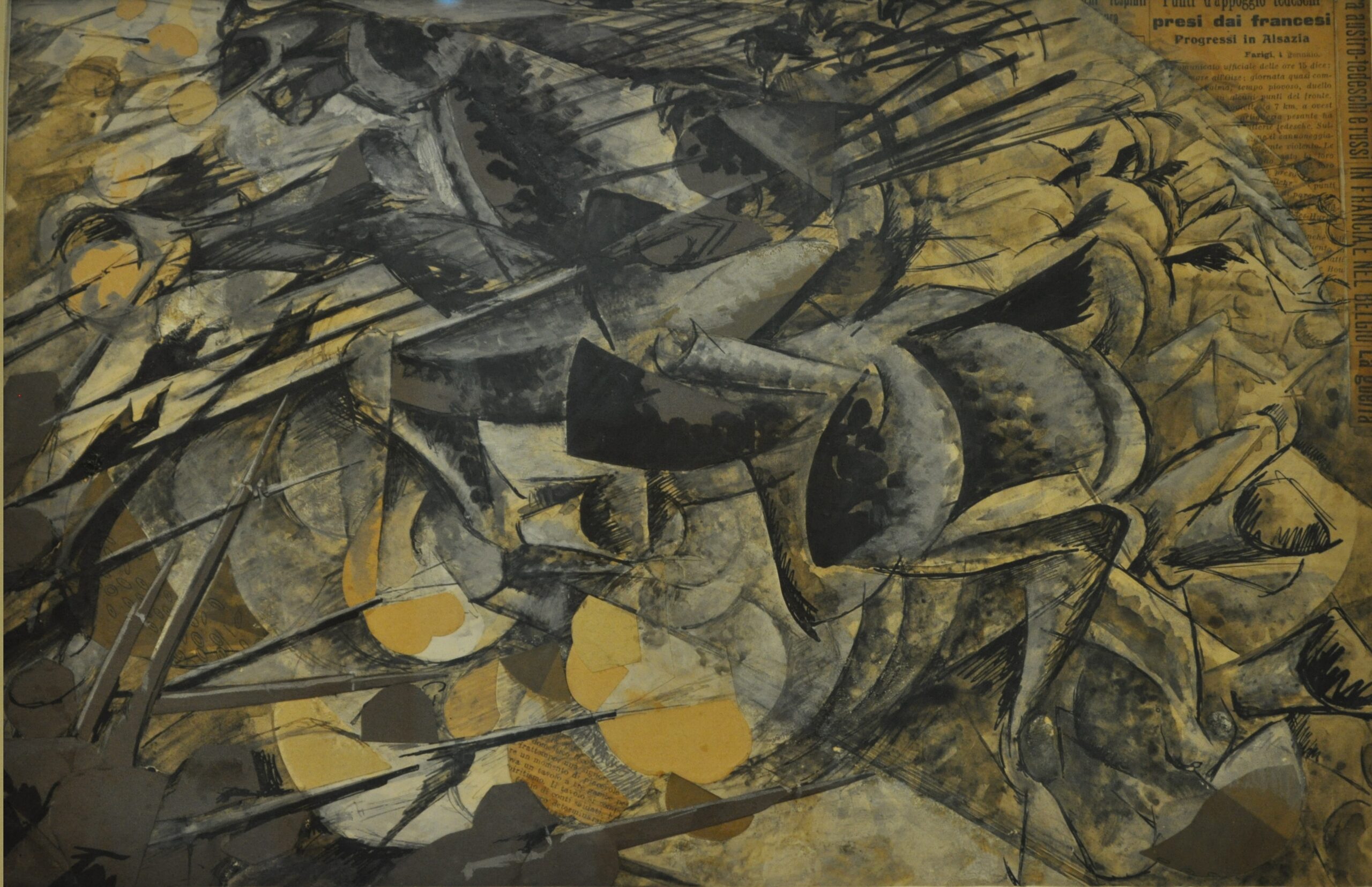
Umberto Boccioni painted Attack of the Lancers in the technique of tempera and collage on cardboard, in 1915. This painting is part of the collection of the Museum of the Twentieth century in Milan. Boccioni structured the theme of violent conflict by grading different visual means arranged diagonally across the image. The reduced palette highlighted the drawing, which with its clarity puts the lower left part of the image in an inferior position in relation to the central part, which with multiplied forms creates the illusion of massive dynamics. An excerpt from the newspaper in the upper right corner closes the diagonal of tension that Boccioni successfully built in this painting.
29. Sea = Dancer (Gino Severini)
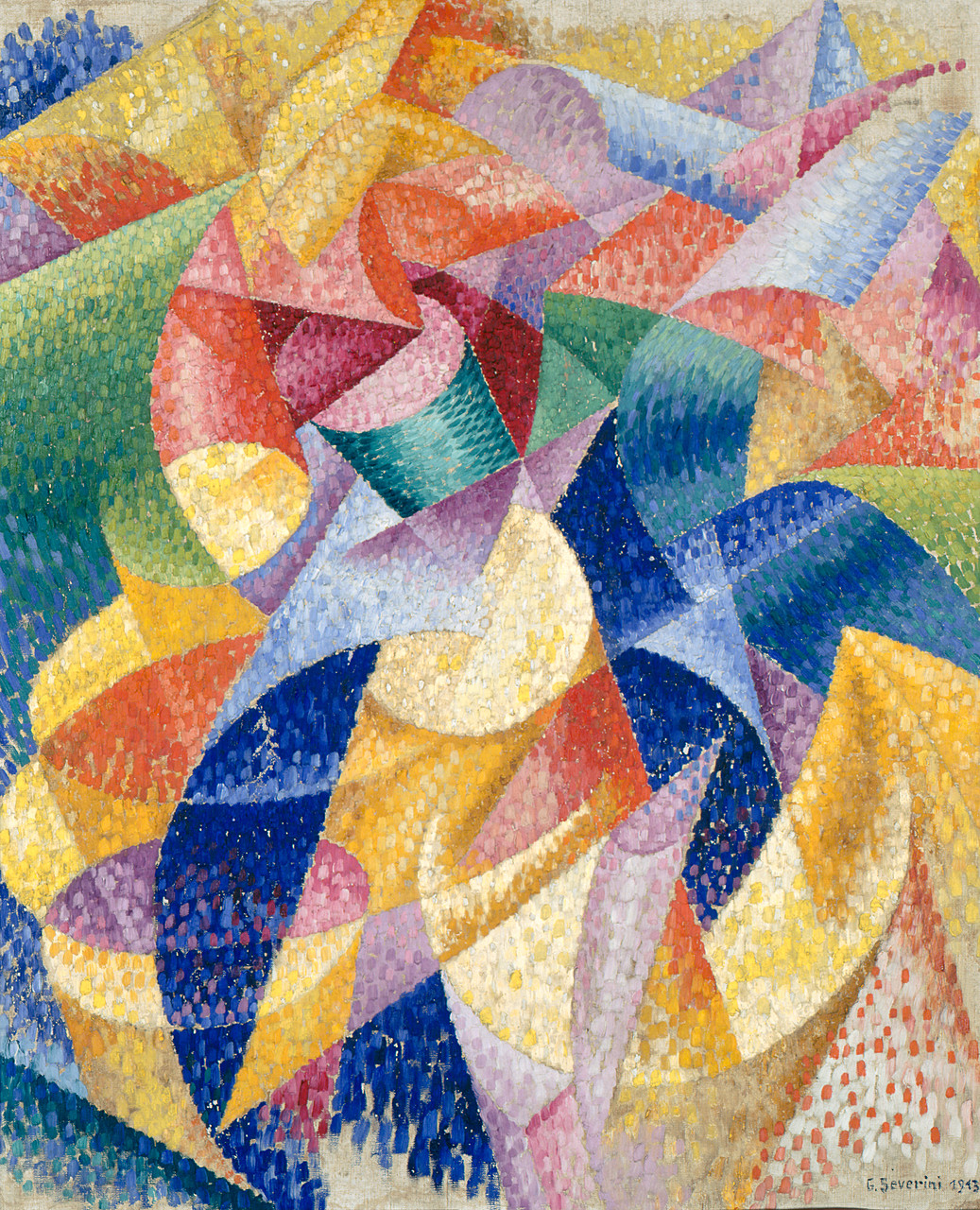
Gino Severini painted Sea = Dancer in oil on canvas, in 1914. This painting is part of the Peggy Guggenheim Collection in Venice. The visual solution generated by this image corresponds to the idea of plastic analogies developed by Severini. The sense of space is based on an optical determination, which is variable or fluid. Thus the human figure becomes inseparable from the reality viewed as a total sensation of movement. Severini further enhances the pulsating character of the painting by arranging almost mosaically small fields of complementary colors.
30. Rotation of Dancer and Parrots (Fortunato Depero)
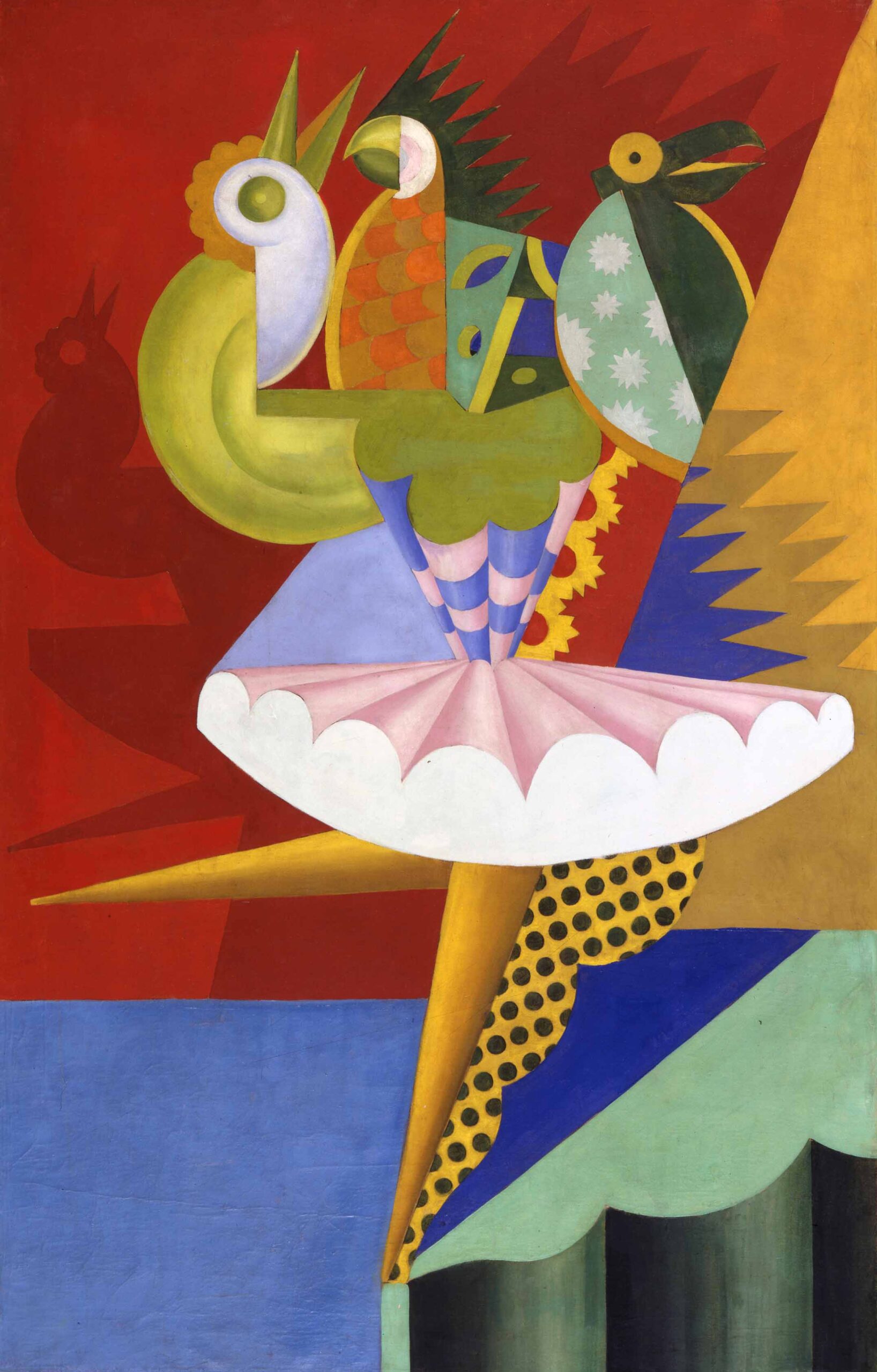
Fortunato Depero painted the Rotation of Dancer and Parrots in the oil on canvas technique, in 1917. This painting is in the Museum of Modern and Contemporary Art of Trento and Rovereto. Depero painted this painting during his collaboration with the Ballets Russes and Sergei Diaghilev as part of the ballet Le Chant du Rossignol, for which the music was written by Igor Stravinsky. Rotation of Dancer and Parrots is one of many artworks in which Depero deals with animal motifs by transforming them in a futurist manner.
31. States of Mind II: Those Who Go (Umberto Boccioni)
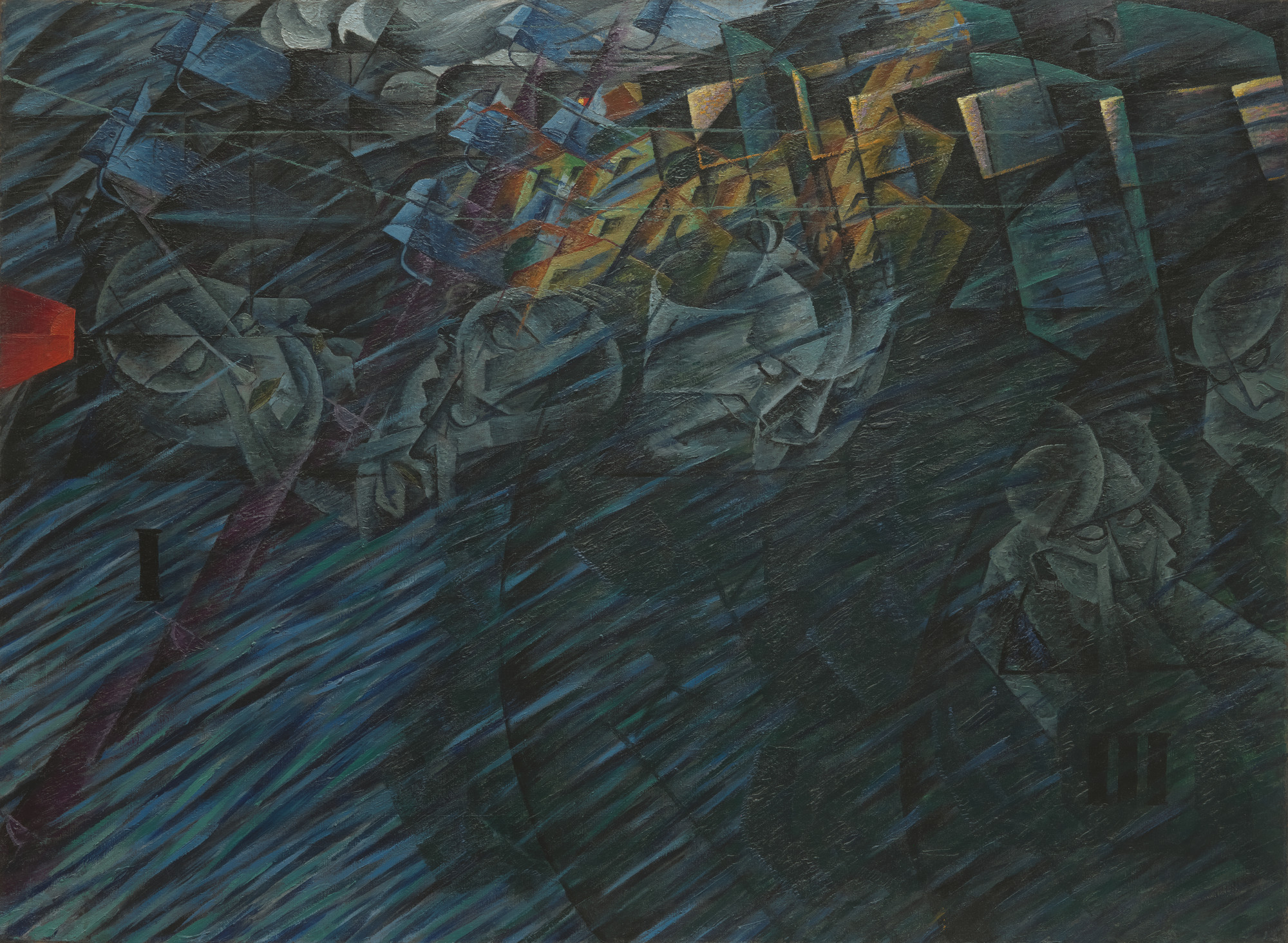
Umberto Boccioni painted States of Mind II: Those Who Go in the oil on canvas technique, in 1911. This painting is part of the collection of the Museum of Modern Art in New York. The painting States of Mind II: Those Who Go is part of a triptych that also includes The Farewells and Those Who Stay. Boccioni here deals with the speed of movement as a consequence of the modern way of life and its repercussions in the domain of psychological changes in man.
32. Bird in motion (Fortunato Depero)
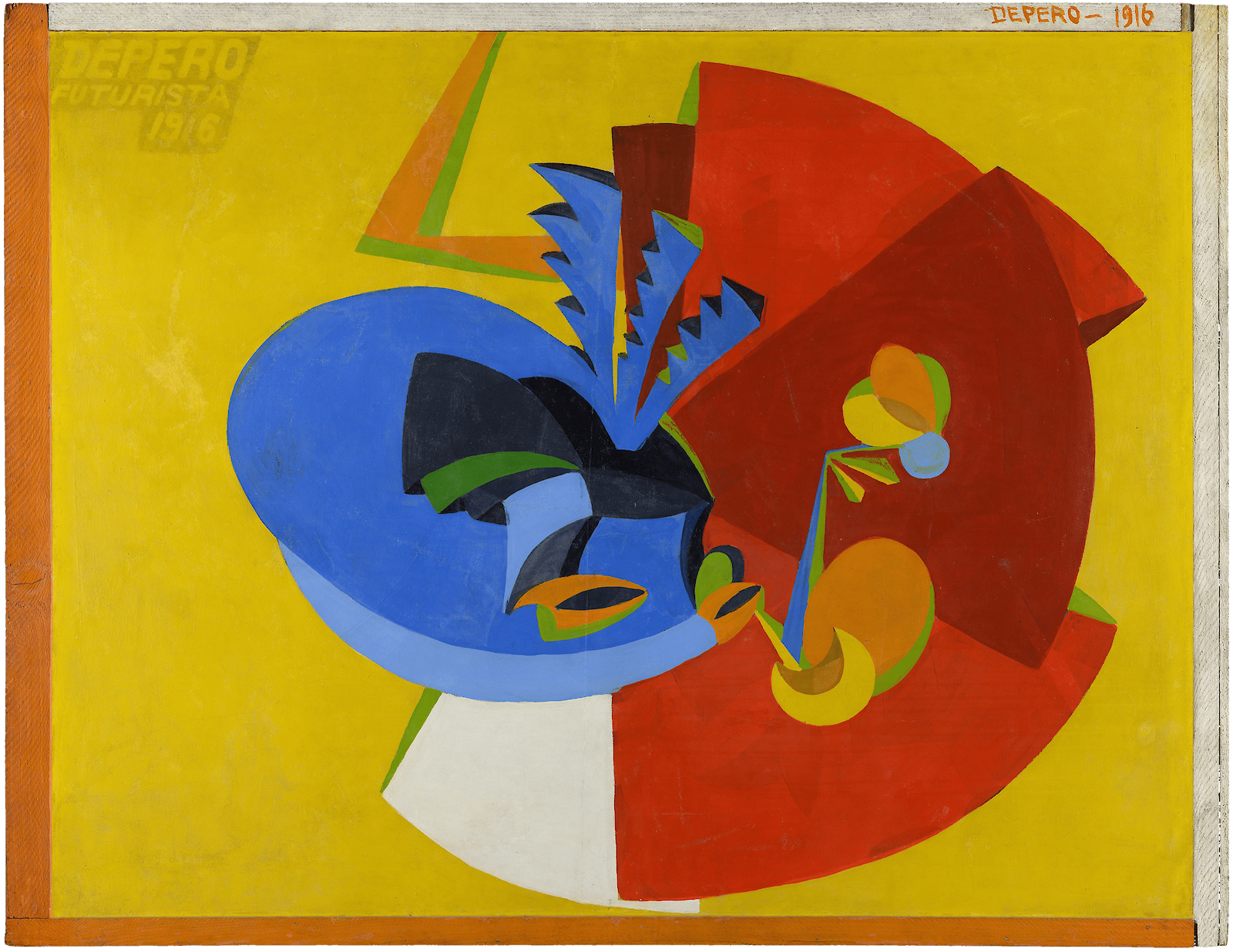
Fortunato Depero painted Bird in motion in oil on canvas, in 1916. This painting is part of the collection of the Museum of Modern and Contemporary Art of Trento and Rovereto in Rovereto. Fortunato Depero meticulously approached the anatomy of animals, which is noticeable in this painting as well. The futuristically geometrized forms of the presented bird are painted in the manner of clear two-dimensionality, which is realized by large fields of pure colors.
33. The chair`s party (Fortunato Depero)

Fortunato Depero completed the tapestry The chair`s party in 1927. This tapestry is part of the collection of the Museum of Modern and Contemporary Art of Trento and Rovereto in Rovereto. The chair`s party was performed in Depero’s authentically futurist manner. This approach is based on flatness, geometrization, and organization of the palette according to the principle of the field of pure complementary colors.
34. The Soul of the Soulless City (Christopher R. W. Nevinson)
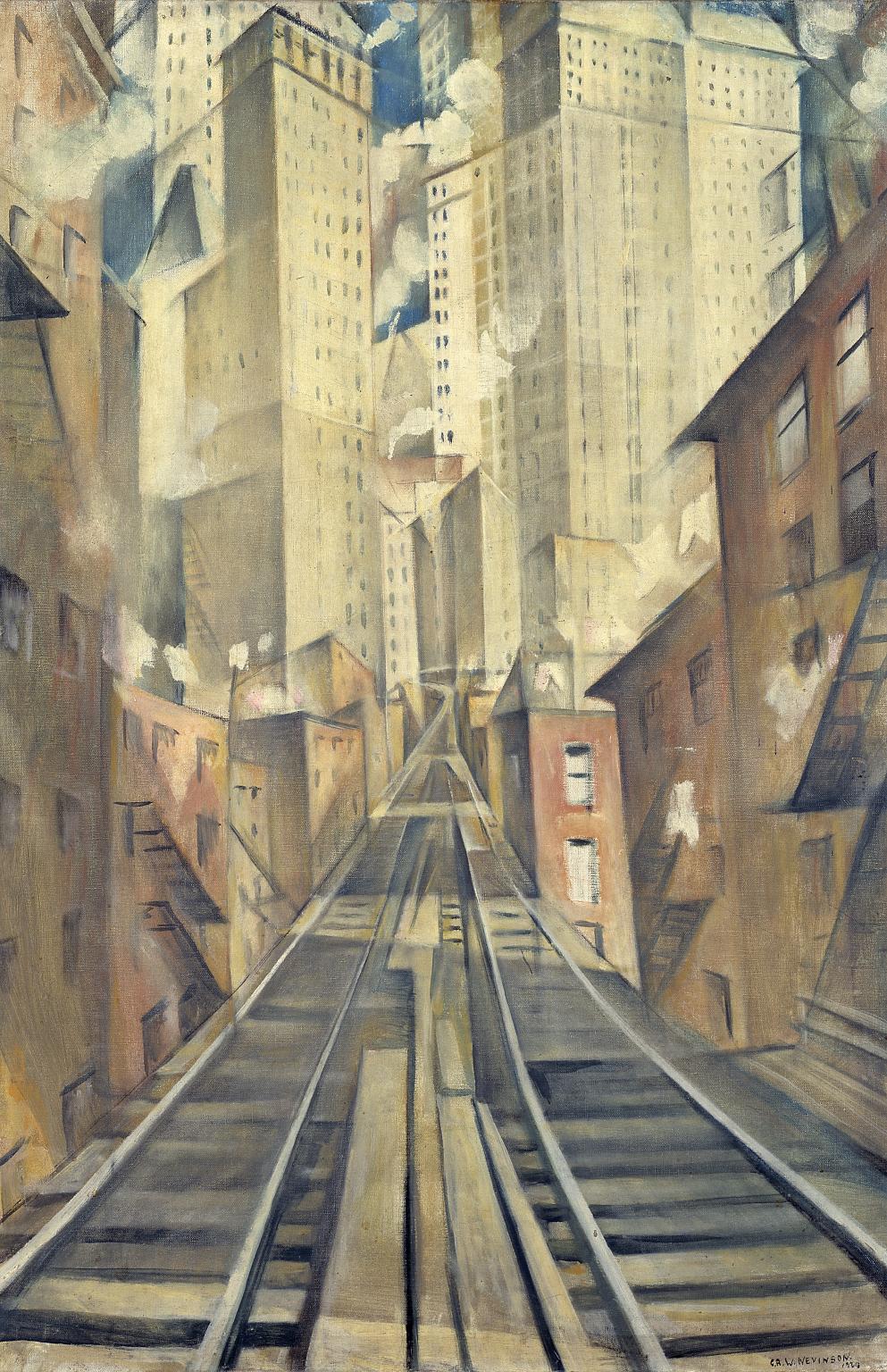
Christopher R. W. Nevinson painted The Soul of the Soulless City in oil on canvas, in 1920. This painting is part of the Tate Gallery collection in London. This painting was taken in London after Nevinson’s first visit to New York. It was exhibited for the first time in 1920 at the Bourgeois Galleries in New York under the name New York – an Abstraction. This painting represents a colorfully reduced, slightly geometric fictional space of an elevated railway in Manhattan. This painting is a kind of praise for the modernization and magnificence of New York urbanism. The next time this painting was exhibited was at the Faculty of Arts Exhibition at Grosvenor House, in London, in 1925, when it was renamed The Soul of the Soulless City.
35. The Street Pavers (Umberto Boccioni)
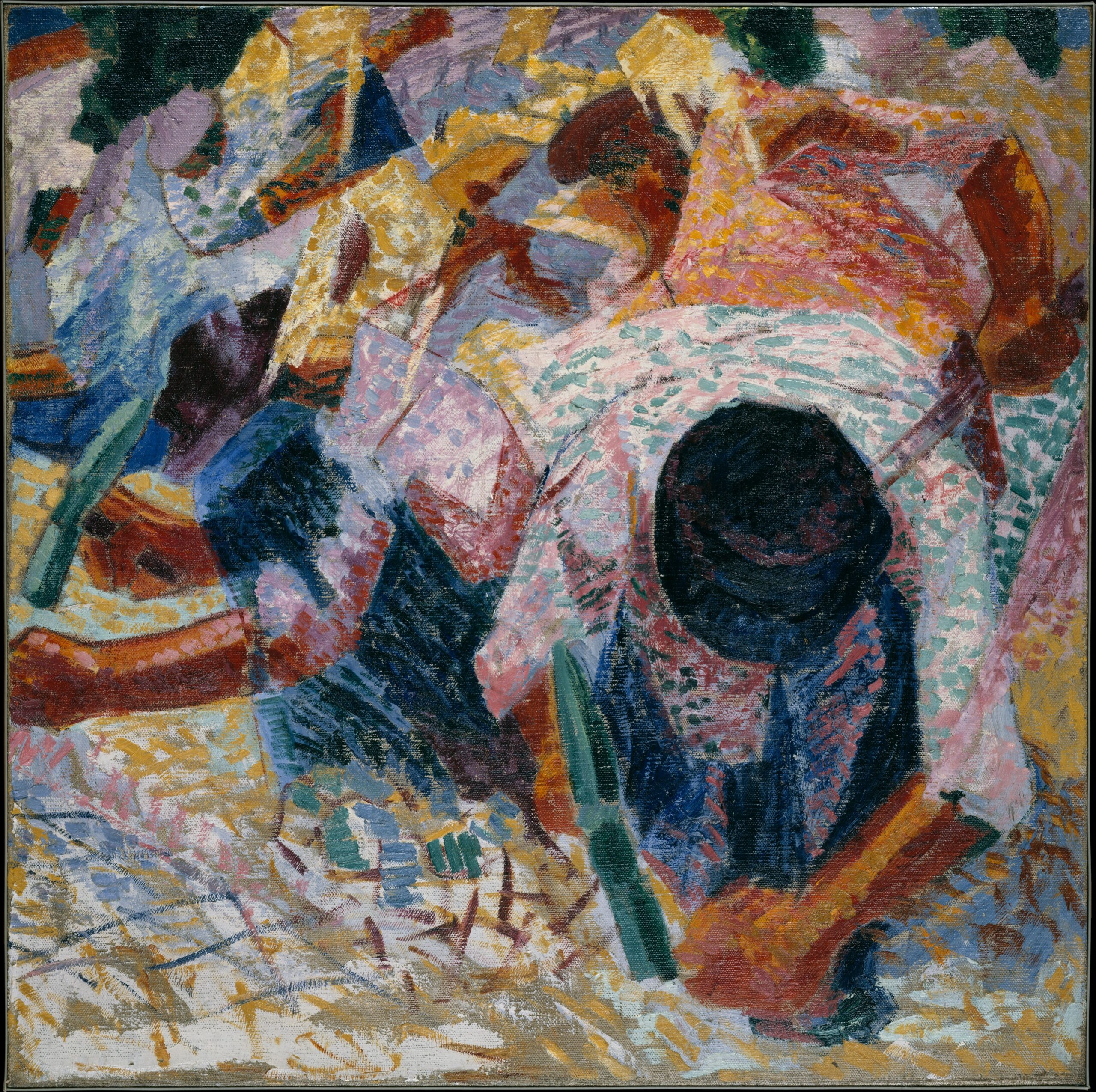
Umberto Boccioni painted The Street Pavers in oil on canvas, in 1914. This painting is in The Metropolitan Museum of Art in New York. Boccioni’s scene of collective hard work as a praise of the potency and strength of the modern worker brings the Neo-Impressionist means of divisionism. The pulsating color of this composition gives it a sense of vitality, regardless of the fact that the faces of the workers are not shown.
36. Dynamism of a Soccer Player (Umberto Boccioni)
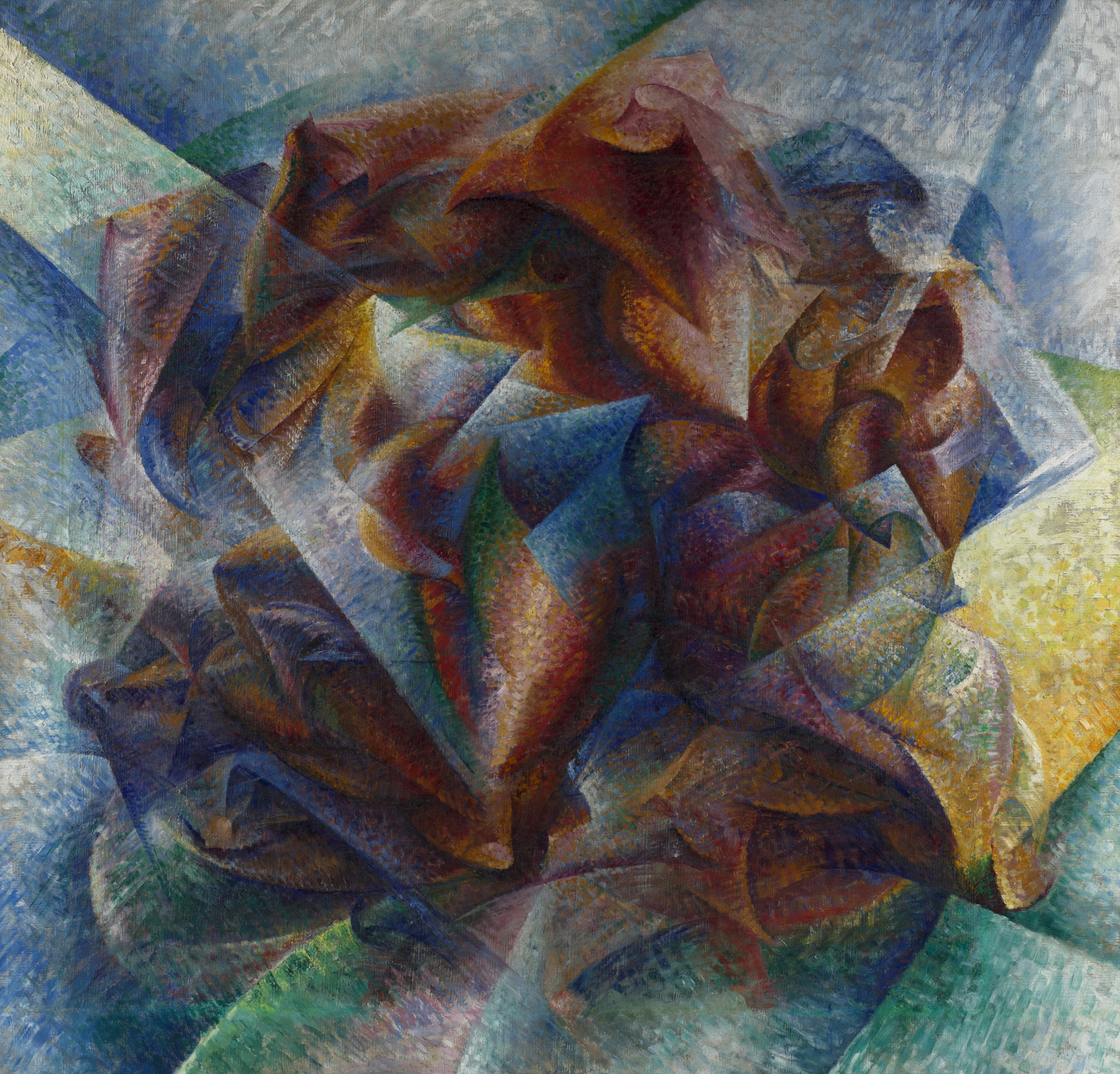
Umberto Boccioni painted Dynamism of a Soccer Player in the oil on canvas technique, in 1913. This painting is part of the collection of the Museum of Modern Art in New York. The cubist principle of the decomposition of the subject is especially expressed in this painting. The dynamism of a Soccer Player is accompanied by the complete dematerialization of the body of a football player whose geometric being becomes one with the space that surrounds him as well as with the light in permanent change.
37. The Miracle of Light While Flying (Gerardo Dottori)
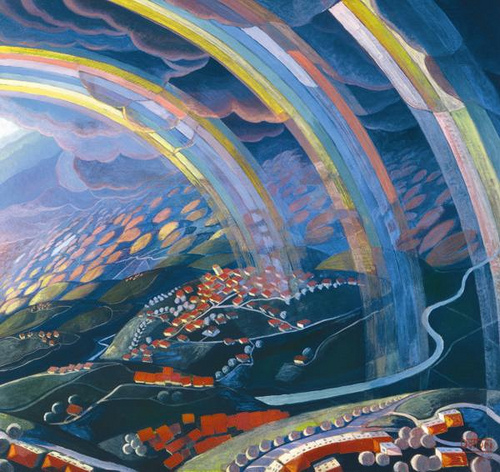
Gerardo Dottori painted The Miracle of Light While Flying in oil on canvas, in 1931. The Miracle of Light While Flying is a representative of a new direction in landscape painting that was created within Futurism and is called Aeropainting. By experimenting with perspective and colorism in this and other related paintings from this period of his work, Dottori erased the boundary between the fantastic imaginary and real recognizable landscape of Umbria.
38. Street Light (Giacomo Balla)
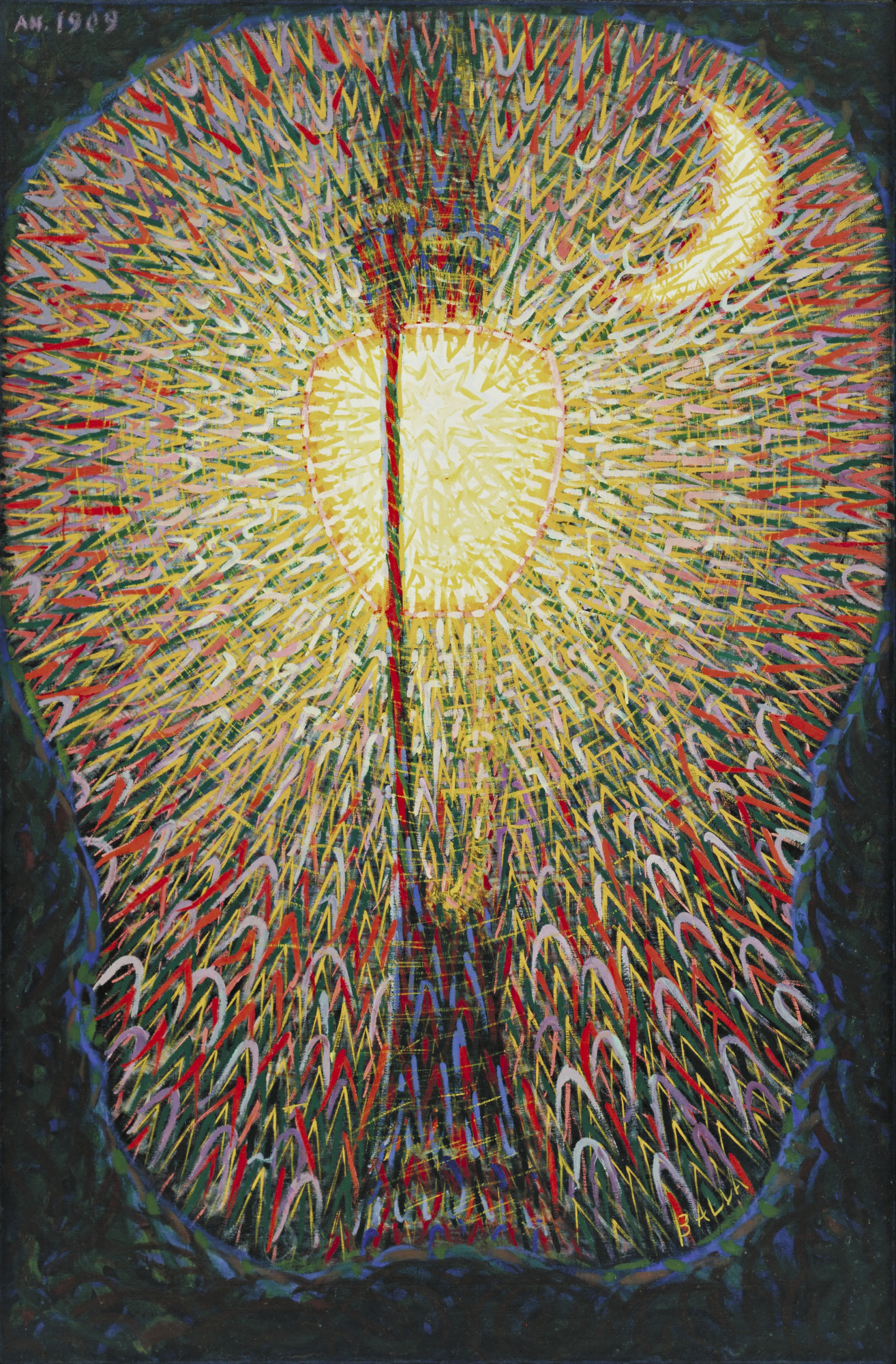
Giacomo Balla painted Street Light in the oil on canvas technique, in 1909. This painting is part of the collection of the Museum of Modern Art in New York. This painting is a reflection of the futurist fascination with artificial light and the increasingly common practice of installing electric lamps in European cities. The predominance of artificial light in this composition is clearly noticeable, considering the position that the moon occupies in relation to the lamp. The flickering and vibrancy of the night lighting was achieved with a divisionist technique.
39. Numbers in Love (Giacomo Balla)
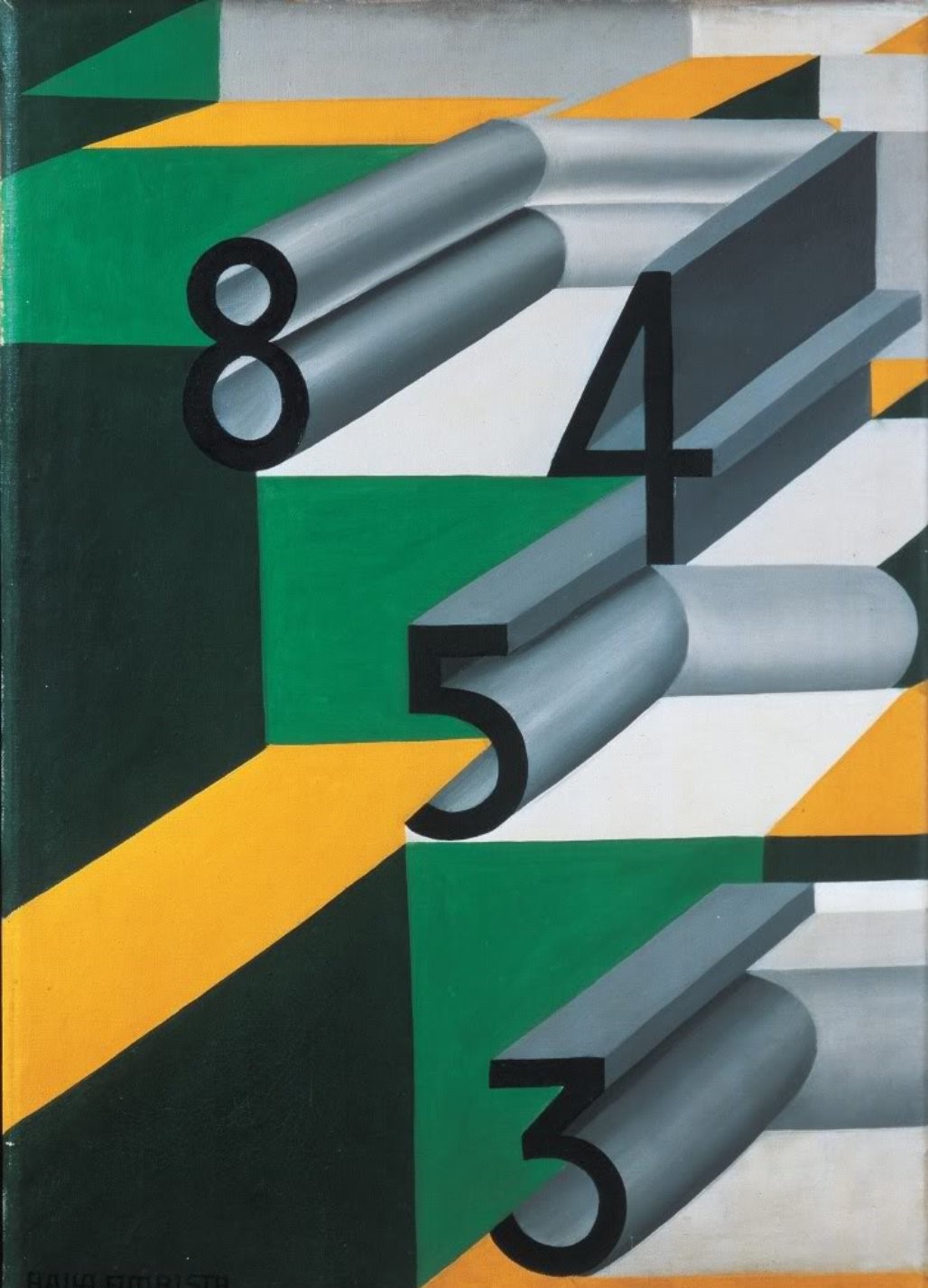
Giacomo Balla painted Numbers in Love in the oil on canvas technique, in 1920. This painting is part of the Museum Ludwig collection in Cologne. This painting is characterized by a harmonious geometrized relationship of fields of six different pure colors, emphasizing numbers as artistic, symbolic, exact, mathematical, but also spatial and emotional values.
40. Cyclist (Natalia Goncharova)
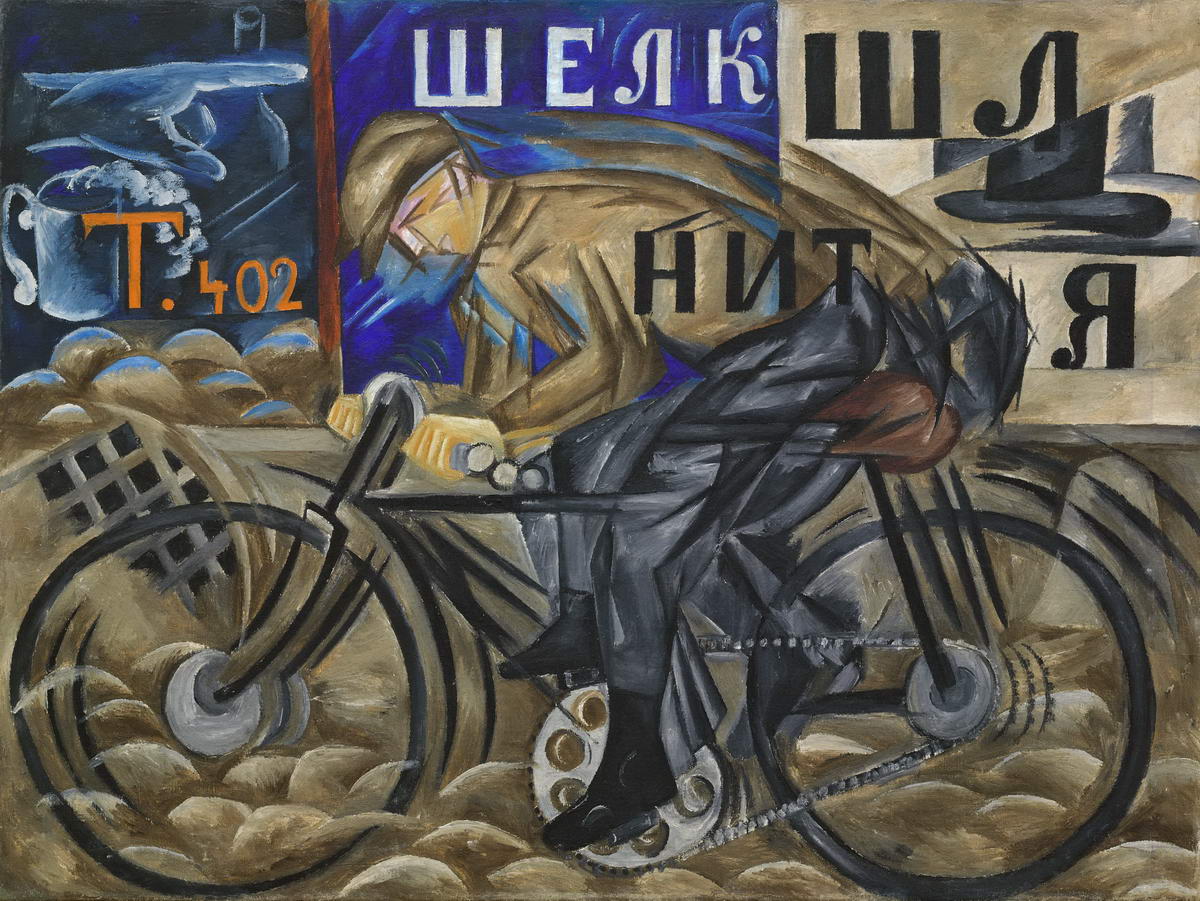
Natalia Goncharova painted Cyclist in the oil on canvas technique, in 1913. This painting is part of the collection of the State Russian Museum in Saint Petersburg. The Cyclist is presented in a milder Cubo-futuristic form, retaining the conventional framework of the figurality. However, the tendency toward fragmentarity as well as the repetitiveness of forms is present. The futurist idea of speed and unification of space and the bearer of movement into a common dynamism was realized in this composition.
41. Aerial landscape (Gerardo Dottori)
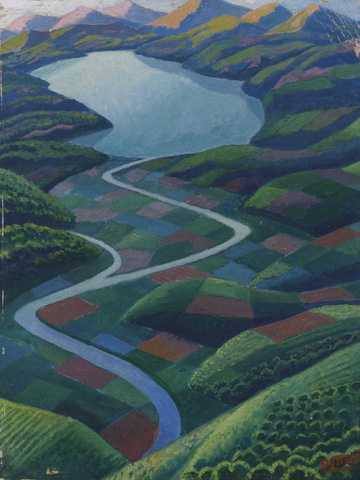
Gerardo Dottori painted Aerial landscape in mixed technique on board, in 1936. The Aerial landscape represents Dottori’s contribution to the development of landscape painting through a new futurist term – Aeropainting. Observing the landscape from a height opened Dottori’s space for experimenting with color-fitting complementary pairs of colors almost as in a mosaic principle.
42. Dancer at Pigalle’s (Gino Severini)
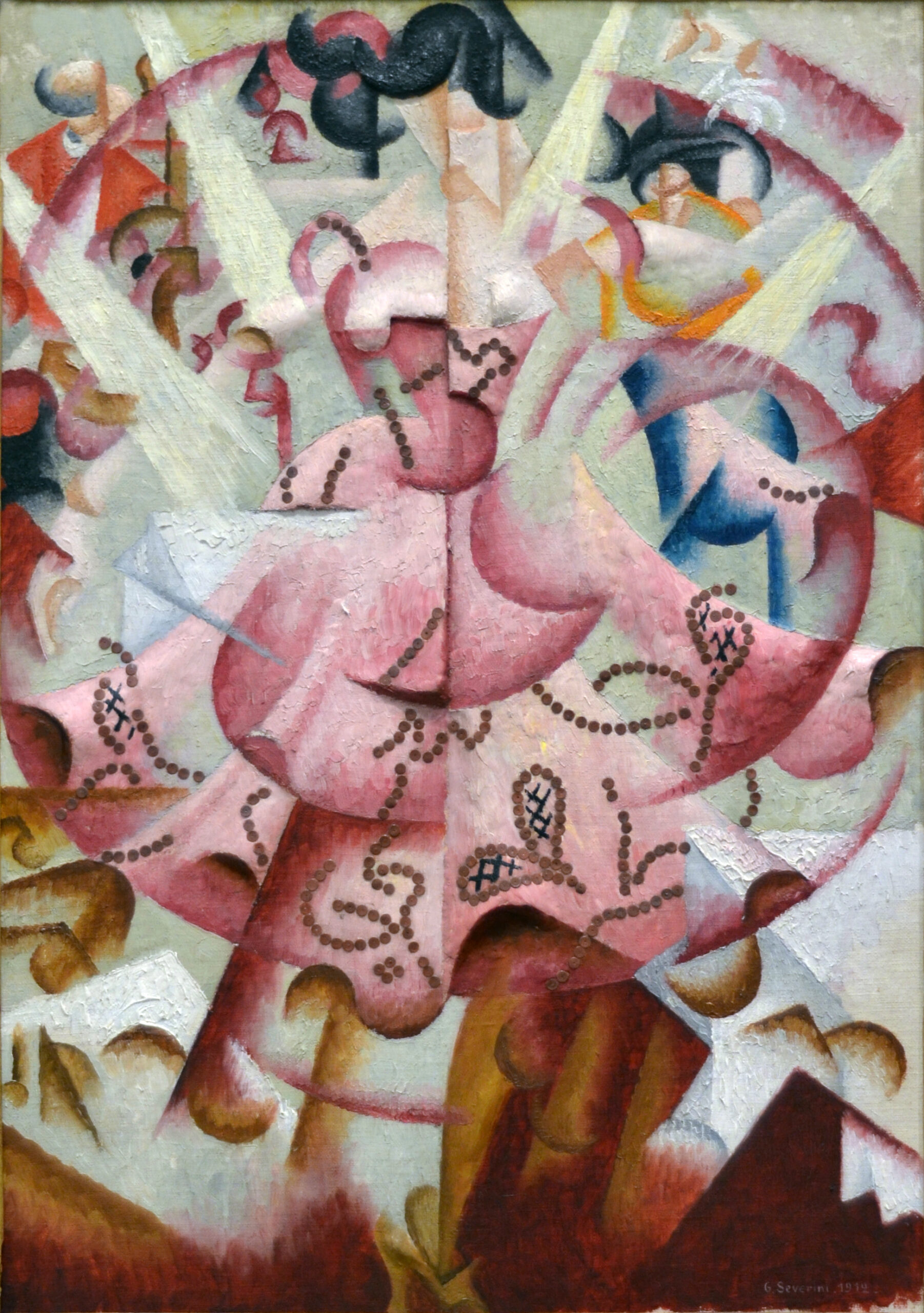
Gino Severini painted Dancer at Pigalle’s oil on canvas technique, in 1912. This painting is housed in the Baltimore Museum of Art in Baltimore. In his work, Severini often dealt with the theme of dancers. In the composition Dancer at Pigalle’s, he conveyed the overall experience of dance through the decomposition of the dancer’s body as well as the light beams that fall on her.
43. Brooklyn Bridge (Joseph Stella)
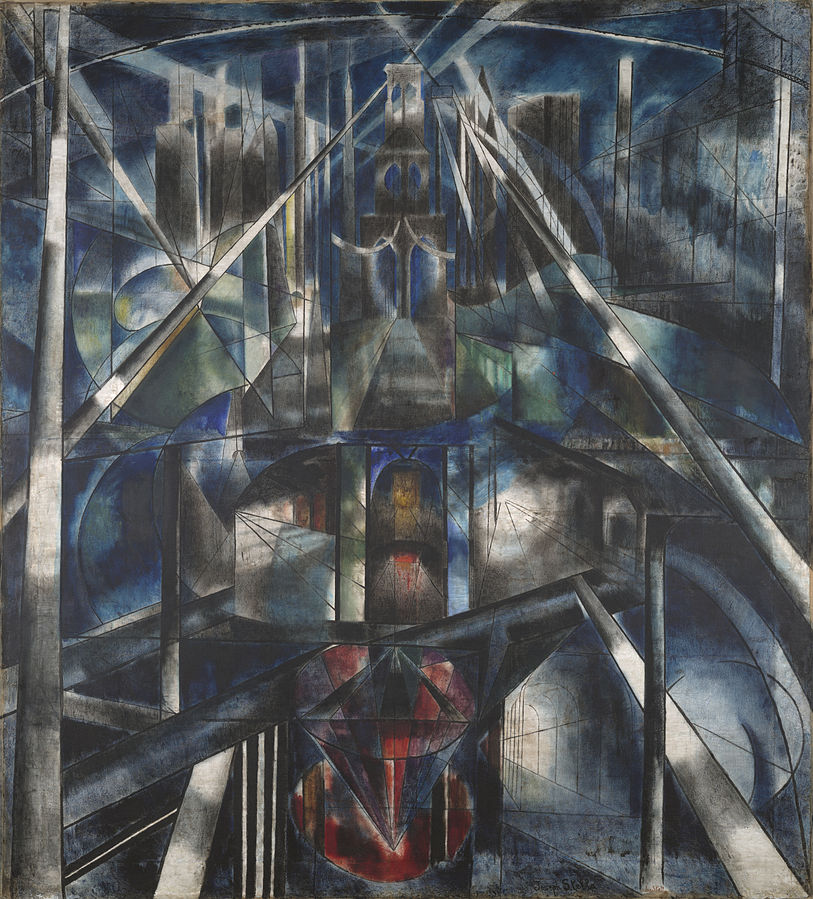
Joseph Stella painted Brooklyn Bridge in the oil on canvas technique, in 1919–20. This painting is housed in the University Art Gallery in New Haven. During his career, Stella returned to the subject of the bridge on several occasions. Because he lived near Brooklyn Bridge, it was a source of continuous fascination and admiration which turned into a painting. The grandeur of the scene carried by the Brooklyn Bridge, and the hinting symmetry of the scene praise the modernization and industrialized dimension that has increasingly transformed New York.
44. Sunrise on the Gulf (Gerardo Dottori)
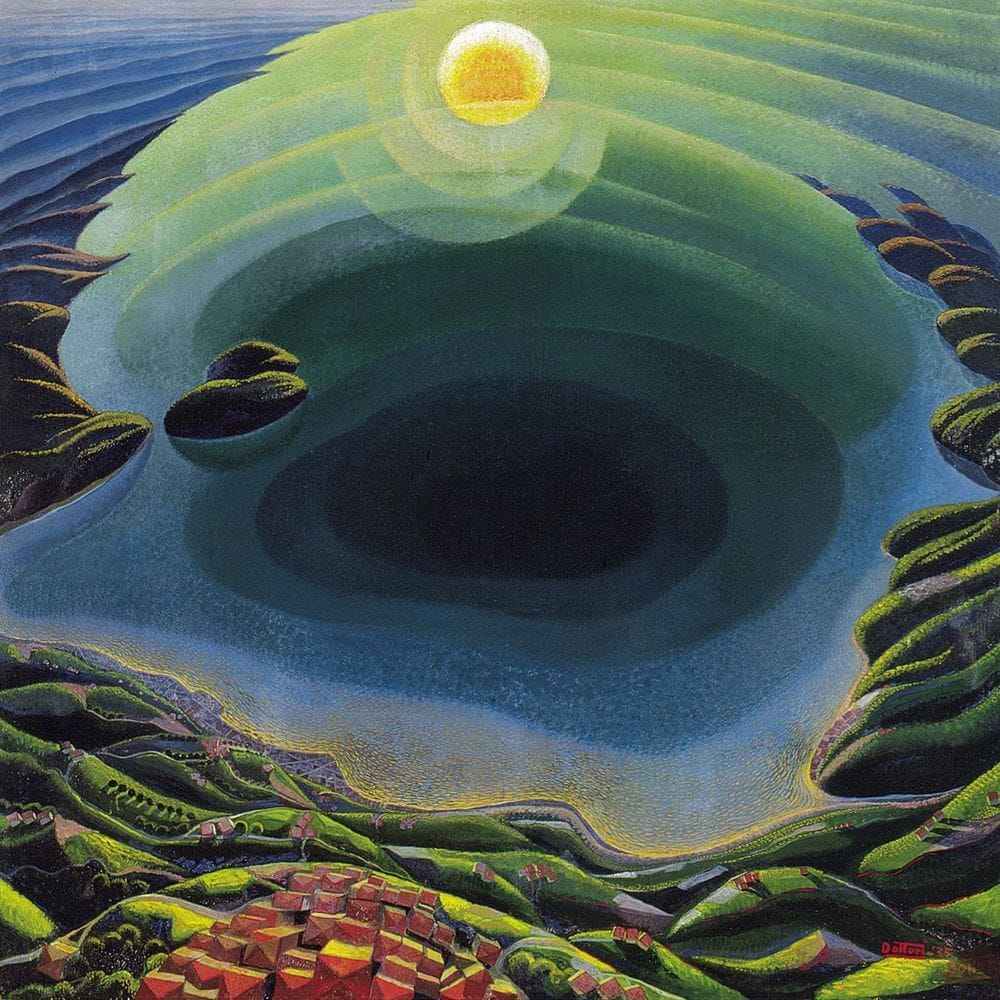
Gerardo Dottori painted Sunrise on the Gulf in 1935. Dottori was the most prominent representative of the Aeropainting technique in which Sunrise on the Gulf was created. Dottori managed to unite the theme of the tranquility of the Mediterranean landscape and the divisionist drama of the reflections of sunlight on the seawater.
45. Under the Pergola in Naples (Umberto Boccioni)
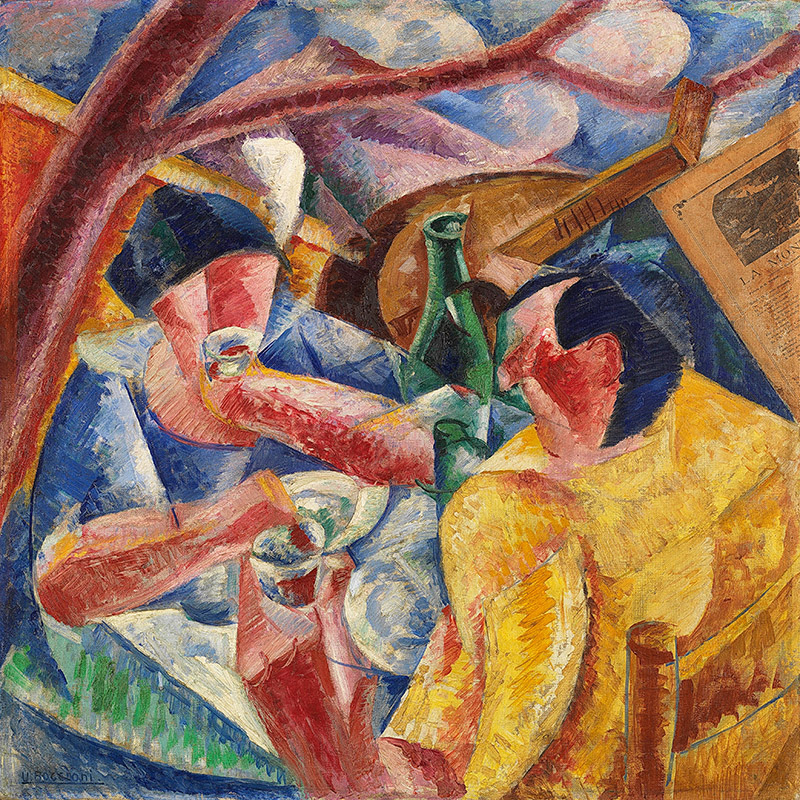
Umberto Boccioni painted Under the Pergola in Naples in the technique of oil and collage on canvas, in 1914. This painting is part of the Modern Art Gallery collection in Milan. Boccioni chose the traditional Mediterranean theme of conversation and lunch under the pergola, which he transformed with avant-garde formal means. By experimenting with plans, intense color, and the introduction of collage components, Boccioni achieved the impression of the authenticity of the atmosphere of the painted scene.
46. Girl Running on the Balcony (Giacomo Balla)
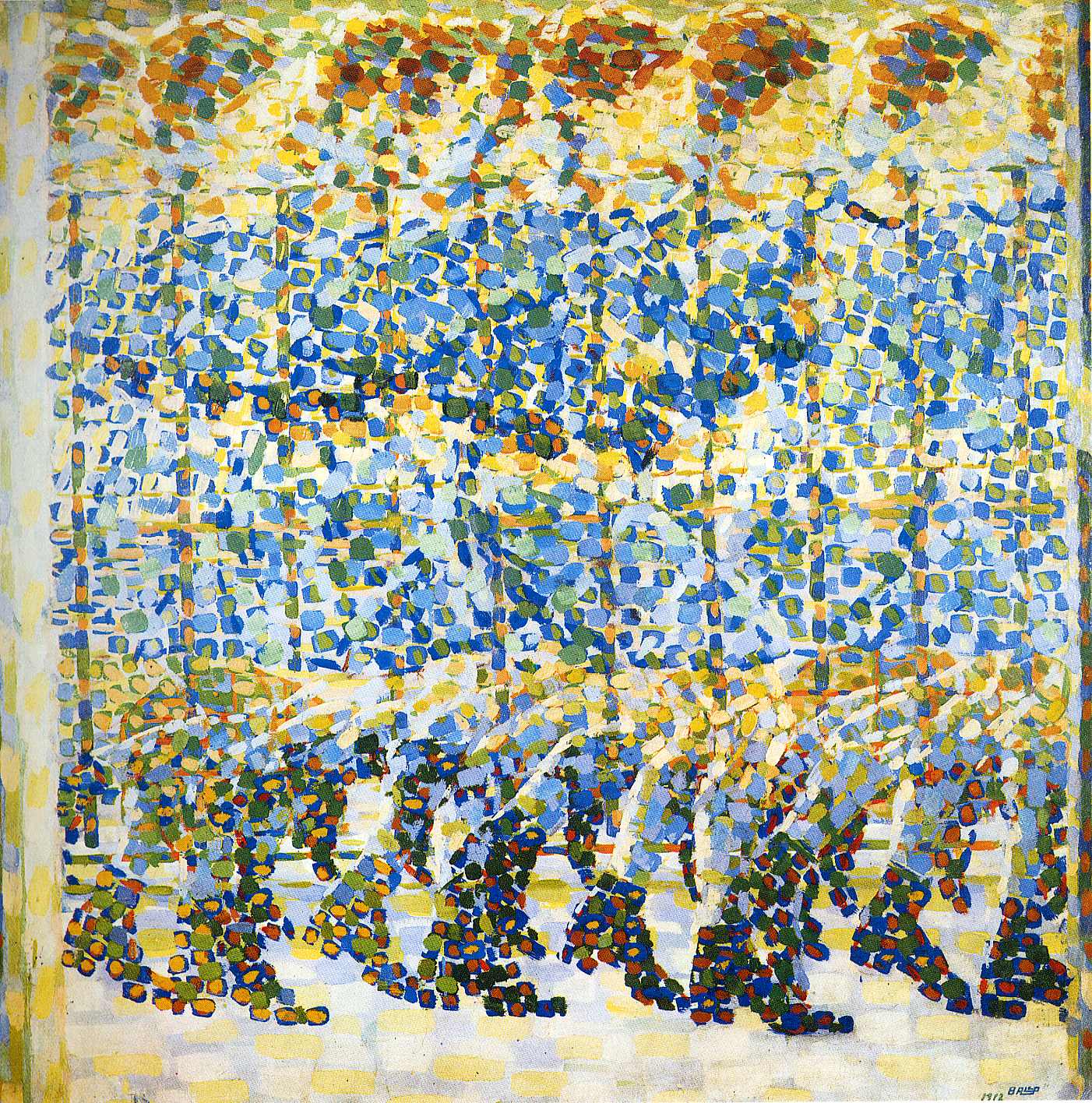
Giacomo Balla painted Girl Running on the Balcony in the oil on canvas technique, in 1912. This painting is part of the Modern Art Gallery collection in Milan. Girl Running on the Balcony combines a futurist preoccupation with dynamism and a Neo-Impressionist color experiment. The multiplied presence of the same girl while running, the absence of the contours of the figure as well as the choice of bright colors resulted in a special pulsating character of the image. Balla used the pointillist approach of applying paint to form a kind of moving mosaic that follows the fragmented movement of the girl through time and space.
47. Iridescent Interpenetration n. 4 – Study of light (Giacomo Balla)

Giacomo Balla painted Iridescent interpenetration n. 4 – Study of light, in oil and pen on paper with canvas backing, in 1912-1913. This painting is part of the Civic Gallery of Modern and Contemporary Art collection in Turin. This Study of light is characterized by a harmonious geometric network designed on the principle of reflection in a mirror. A simple color solution is based on the relationship between shades of blue and yellow.
48. Futurist Composition (Joseph Stella)

Joseph Stella painted the Futurist Composition, in pastel over graphite on paper, in 1914. This painting is part of the collection of the Amon Carter Museum of American Art in Fort Worth. After returning to New York from Europe, Stella, inspired by futurist ideas, began to thematize elements of modern life in the city. Futurist Composition is one of the abstract paintings created as a result of impressions left on Stella by the city lights.
49. Italy Between the Arts and Sciences (Mario Sironi)
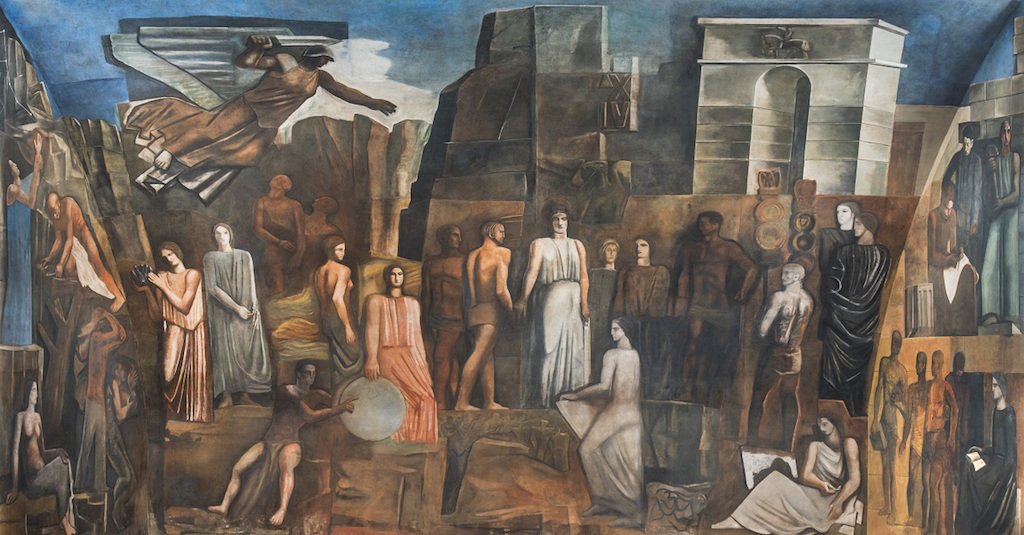
Mario Sironi completed the mural Italy among arts and sciences in 1935. This mural is located in the Main lecture room of the University of La Sapienza in Rome. It represents a group allegorical composition traditionally conceived but formally performed in a modernist manner. The fascist symbols that were part of the original mural were later removed and today this mural can be seen in a restored form.
50. A horse-lightning (David Burliuk)
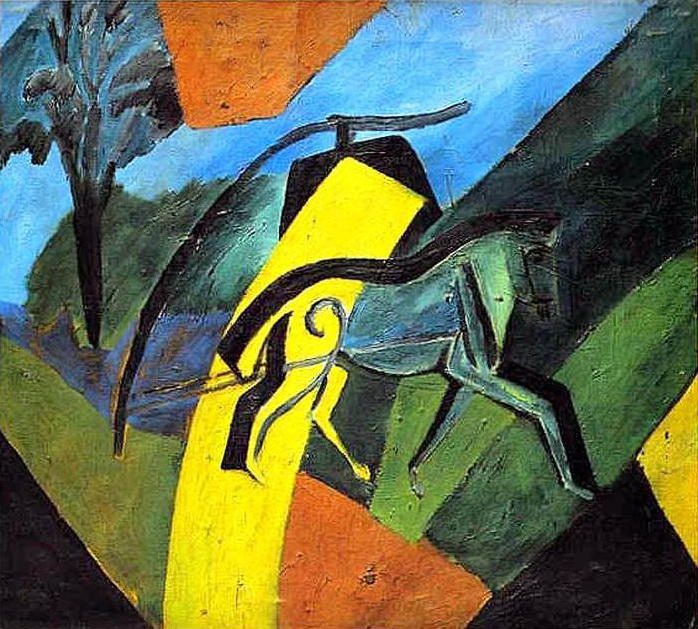
David Burliuk painted Horse-lightning in the oil on canvas technique, in 1907. This painting is in the State Russian Museum in Saint Petersburg. Burliuk often returned to the motif of a horse through his painting, which is the focus of this composition as well. Clearly defined and divided fields of pure colors form a flat base on which the contours of the figure of a horse stand out, which achieves a spatial and symbolic unity with lightning.
51. Abstract Speed – The Car has Passed (Giacomo Balla)
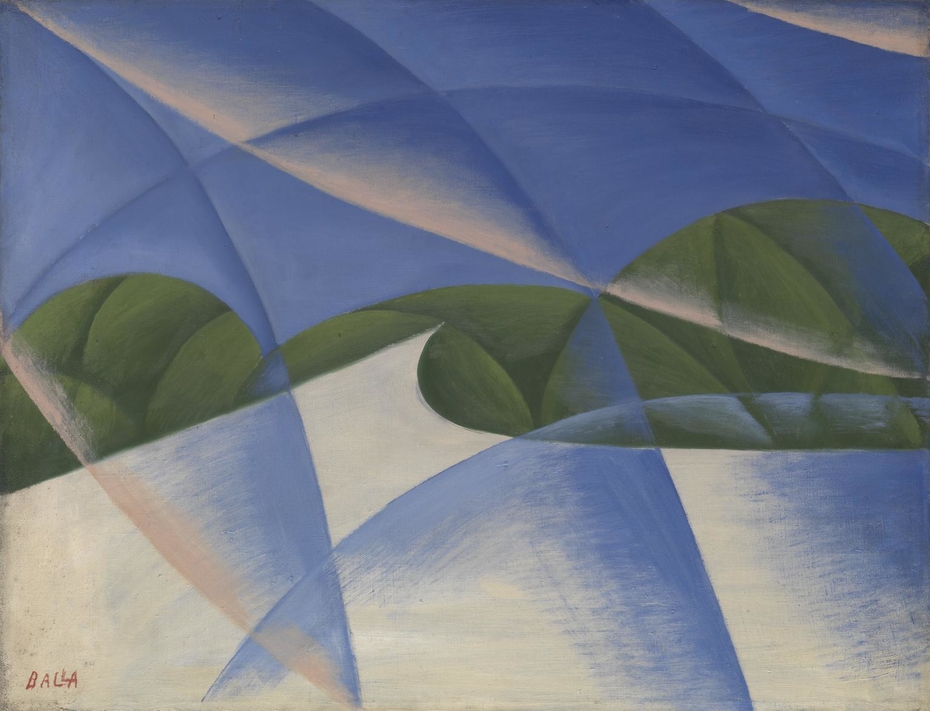
Giacomo Balla painted Abstract Speed – The Car has Passed in oil on canvas, in 1913. This painting is part of the Tate Gallery collection in London. Abstract Speed – The Car has Passed is the last painting of a triptych that make up both Line of Force + Landscape and Lines of Force + Noise. The fascination with speed and dynamism is reflected in the numerous works that thematized the car in motion. A car that passes through the landscape at high speed, simultaneously transforming itself and space, is the theme of this triptych. The painting Abstract Speed – The Car has Passed builds a visual hint of the car’s former presence in a space that is now empty.
